Scottish Castles & Palaces
Castle construction in Scotland started with the reign of
David I Dunkeld in the 12
th century. Living in England as a young man, he saw the castles built by the Normans.He invited
Norman nobles to Scotland and granted them titles and lands on which they built their castles. Early on many of the
Clan Chiefs built
Tower castles. Many were built in the
Scottish Borders where attacks from English
reivers were common. Later on many of the larger Scottish tower castles were enclosed to create many of the larger castles we see today. In more peaceful times, wealthy and royal families improved many castles into more resplendent country manners.
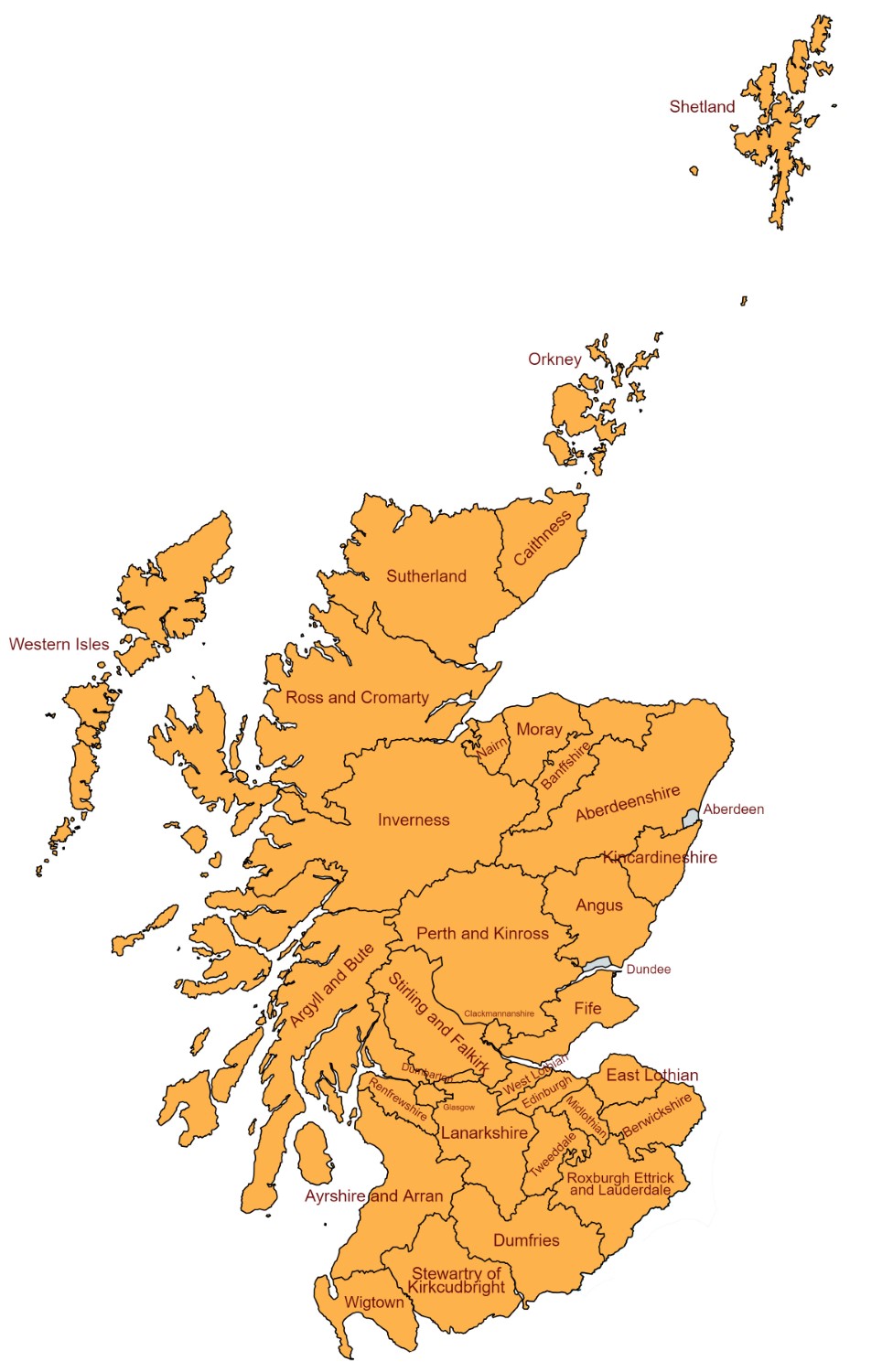
Palaces are not as prevalent in Scotland as they are in England. Some of the more well known Scottish palaces includes the
Royal Holyrood Palace,
Linlithgow Palace and
Scone Palace, the original site of the
Stone of Destiny and the traditional site of the
Coronation of Scottish Kings.
My first question is how many castles are there in Scotland? It is estimated that
2000 to 3000 have been constructed over time.
In the following table of Scottish Castles, the numbers beside the county indicate the number of castles in the county while the number in parenthesis shows the number that are considered "ruins". For a map of the Castles below
click here.
Scottish Castles
| County Castles(Ruins) | County Castles(Ruins) | County Castles(Ruins) |
|---|
| Aberdeen 3(2) | East Renfrewshire 3(0) | Orkney 8(7) |
| Aberdeenshire 88(44) | Edinburgh 13(1) | the Outer Hebrides 7(3) |
| Angus 52(7) | Falkirk 8(4) | Perth and Kinross 37(10) |
| Argyll and Bute 44(24) | Fife 37(16) | Renfrewshire 15(12) |
| Clackmannanshire 6(2) | Glasgow 5(4) | the Borders 42(23) |
| Dumfries and Galloway 99(53) | Highland 65(41) | Shetland 4(0) |
| Dundee 6(2) | Inverclyde 8(5) | South Lanarkshire 23(20) |
| Ayrshire 94(58) | Midlothian 9(1) | Stirling 12(4) |
| East Dunbartonshire 3(2) | Moray 40(33) | West Dunbartonshire 7(0) |
| East Lothian 33(6) | North Lanarkshire 2(0) | West Lothian 23(5) |
| Data from https://en.wikipedia.org/wiki/List_of_castles_in_Scotland |
|---|
Edinburgh Castle, Edinburgh (2003, 2005 & 2008)
Edinburgh Castle is probably the most well known and recognizable castle in Scotland. It stands high upon
Castle Rock, a volcanic plug in the middle of Edinburgh. It has been occupied since at least the
Iron Age. It was first built in
1103 and has been a Royal castle since the reign of
Malcolm III. From about the 15
th century, its role as a Royal residence has declined and by the 17
th century its primary use was as a
military garrison.
Today the Castle serves mainly as a
tourist attraction averaging about
2 million visitors per year. It houses the
Honours of Scotland (the Scottish Crown Jewels) and numerous buildings of note. It also remains the regimental headquarters of the
Royal Regiment of Scotland and the
Royal Scots Dragoon Guards and houses their regimental museums, along with that of the
Royal Scots. It also serves as the backdrop to the
Royal Edinburgh Military Tattoo during the annual Edinburgh Festival held every August.



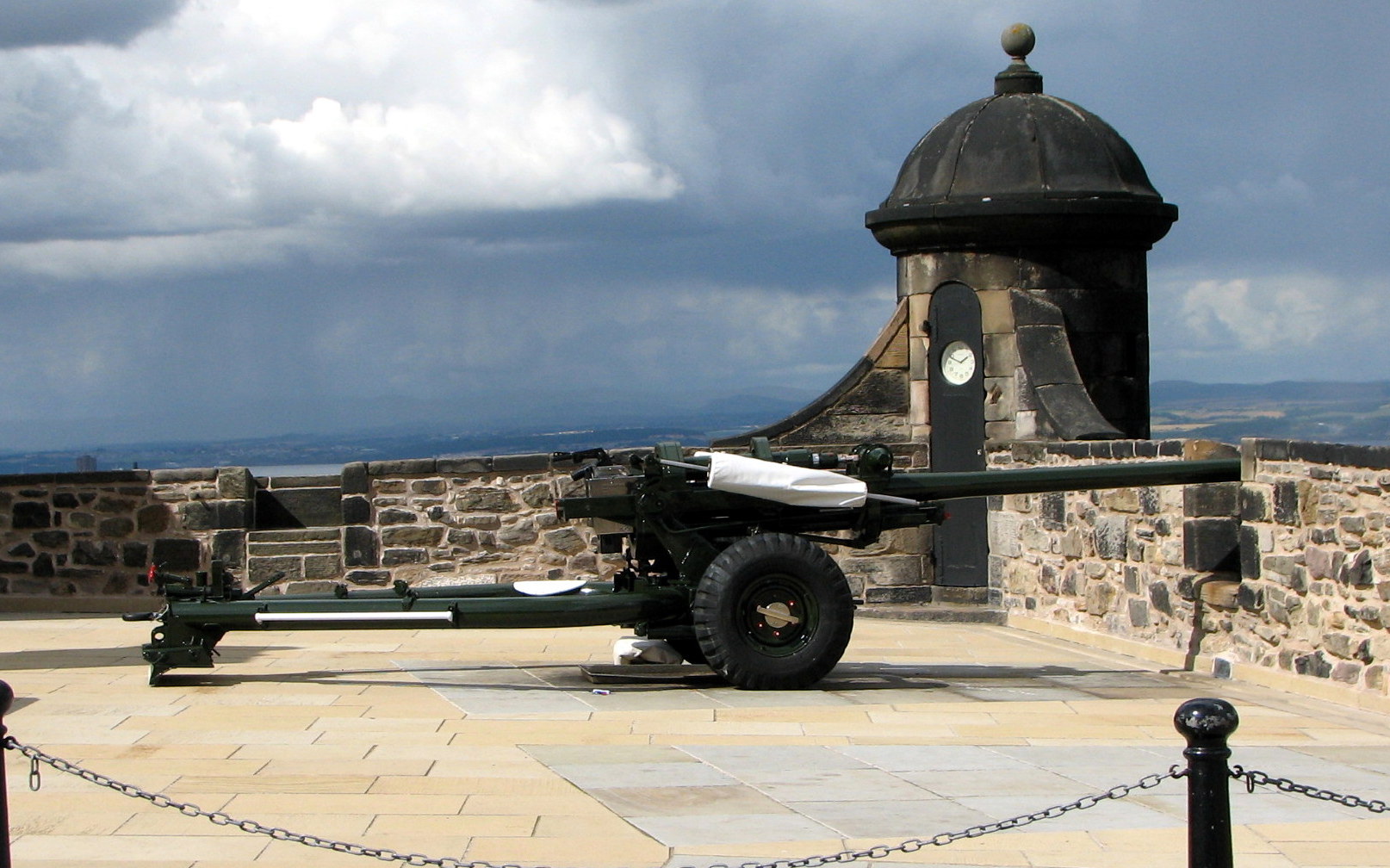

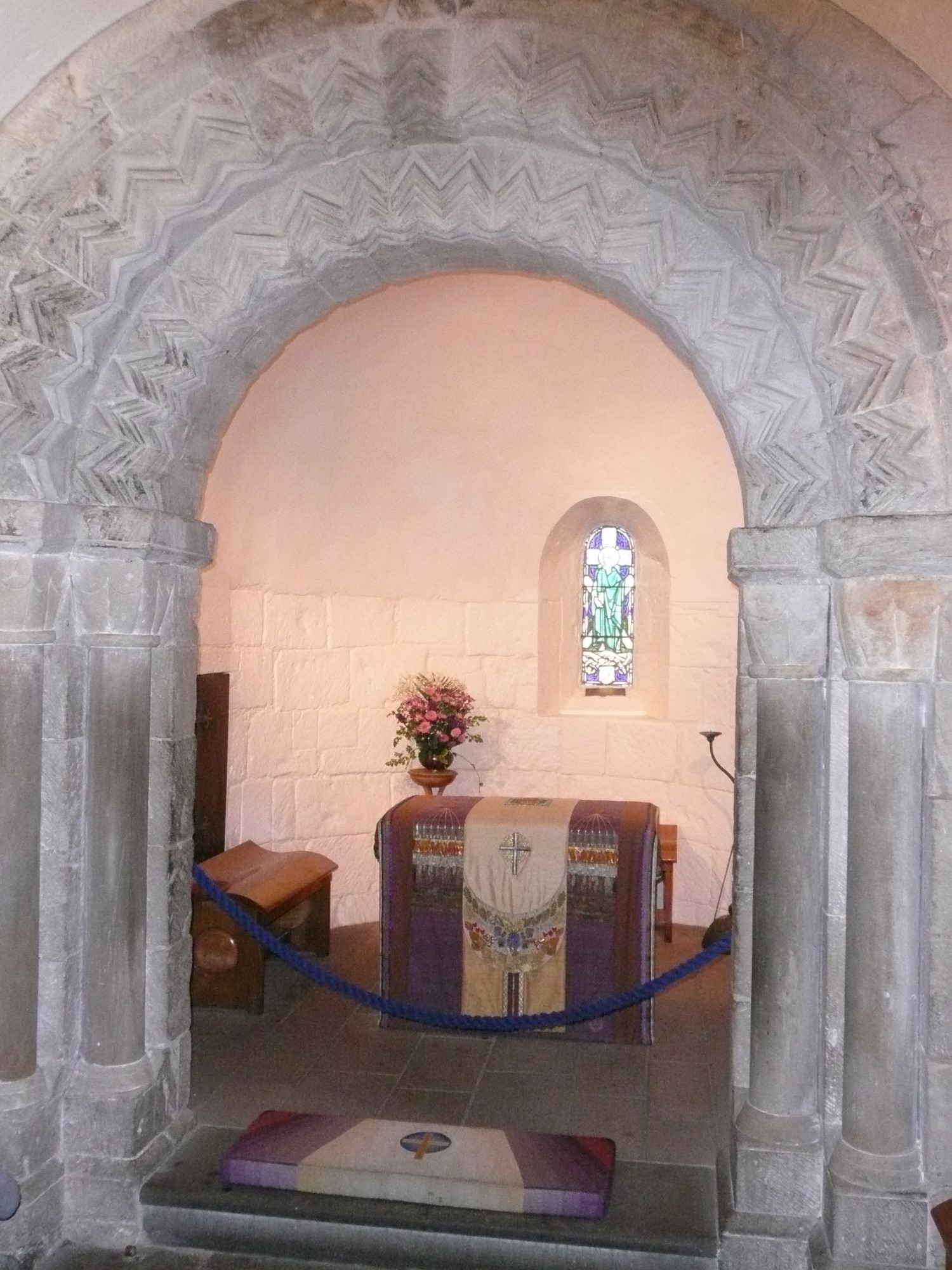
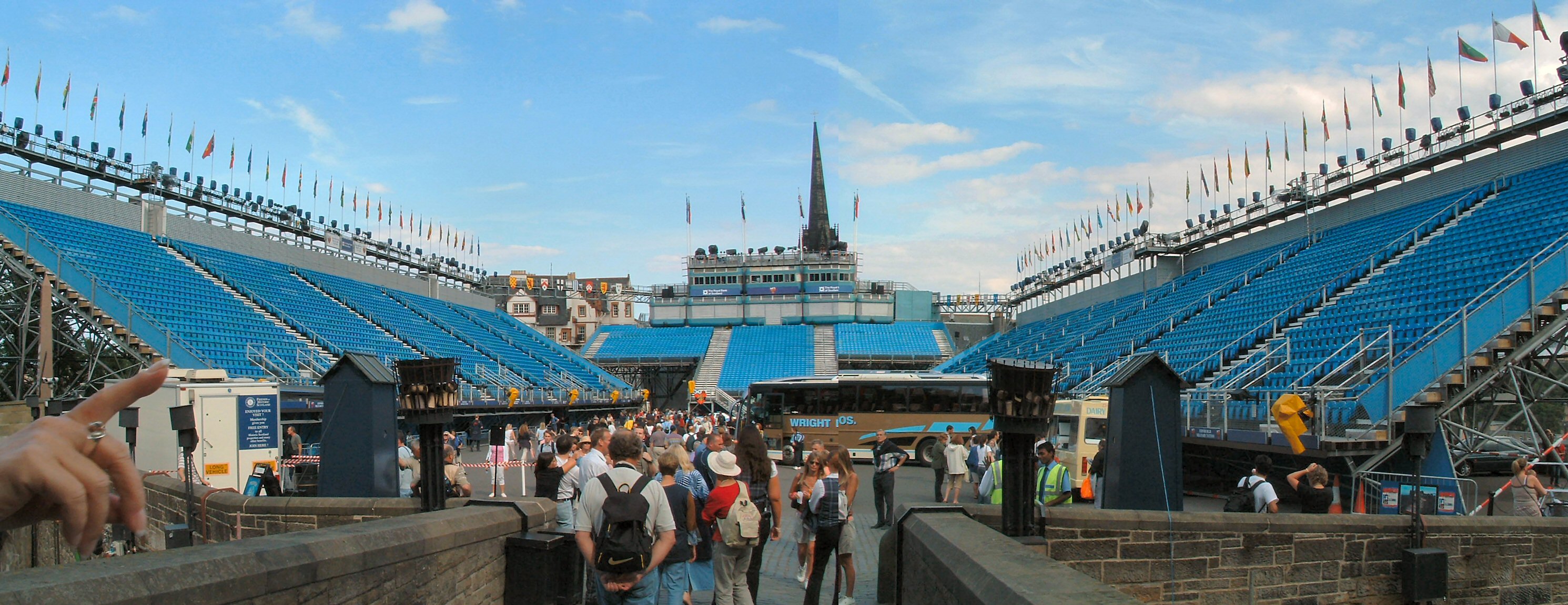
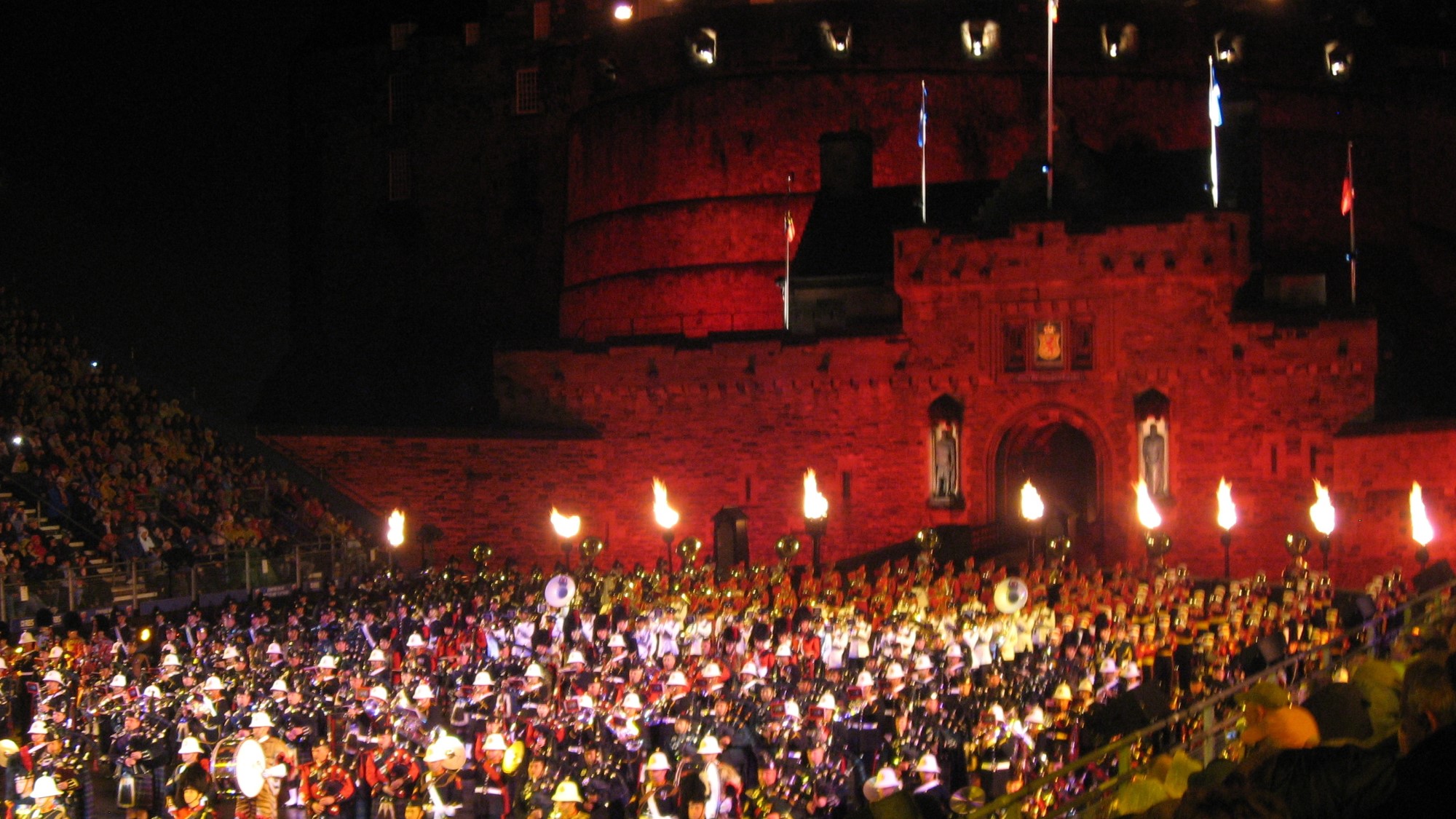 Glamis Castle, Angus (2003)
Glamis Castle
Glamis Castle, Angus (2003)
Glamis Castle was built in
1372 and granted by Robert II to his son-in-law
Sir John Lyon, Thane of Glamis. It has remained in the Lyon name since then. Originally constructed as a
Tower Castle, over time two wings were added making it shaped like an L. There are many strange stories associated with Glamis. One involves a card game with the
devil which possibly included the Lord of Glamis, Alexander Lyons, himself. Another involves the deformed child, the "
Monster of Glamis", son of another Lord Glamis who was hidden away for his entire life. Upon his death, the rooms he had occupied were bricked up. Glamis was also the scene of
Shakespeare's "Macbeth". Unfortunately for Shakespeare, Macbeth lived about 300 years before Glamis was built.
A true story is that
Lady Elizabeth Bowes Lyon, though not born at Glamis, spent much of her life there after her father inherited Glamis and the Earldom of Strathmore. She spent much of her young life there and married the future
King George VI and became the
Queen Mother to
Queen Elizabeth II.
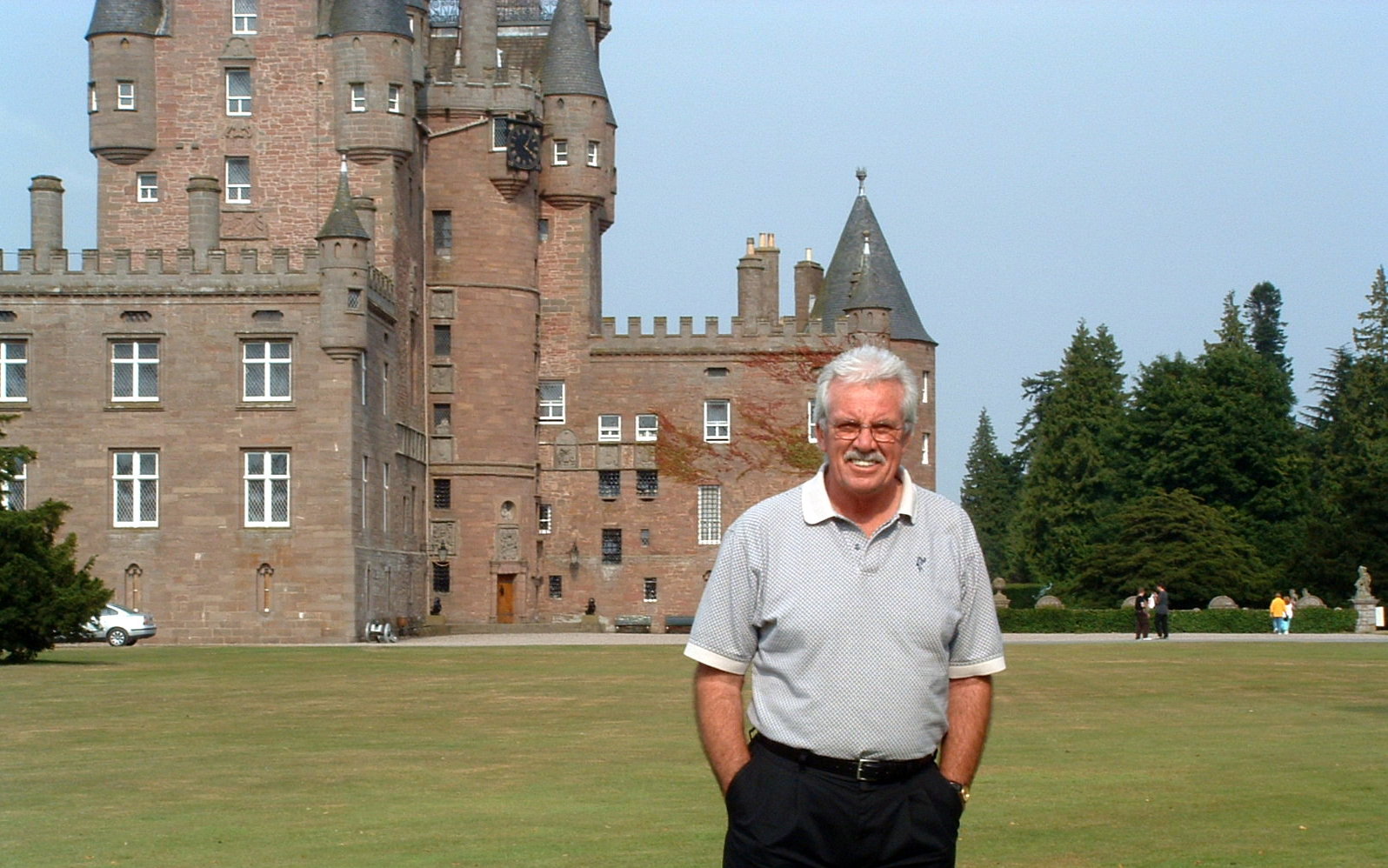 Crathes Castle, Aberdeenshire (2003 & 2005)
Crathes Castle, Aberdeenshire (2003 & 2005)
Built in the 16th century near Banchory by the
Burnetts of Leys, Crathes Castle sits on land given to the Burnett family by
King Robert the Bruce in 1323. Originally built as a
Tower Castle, a residential wing was added in the 18
th century. Today, Crathes is probably best known for its 4 acre walled garden.
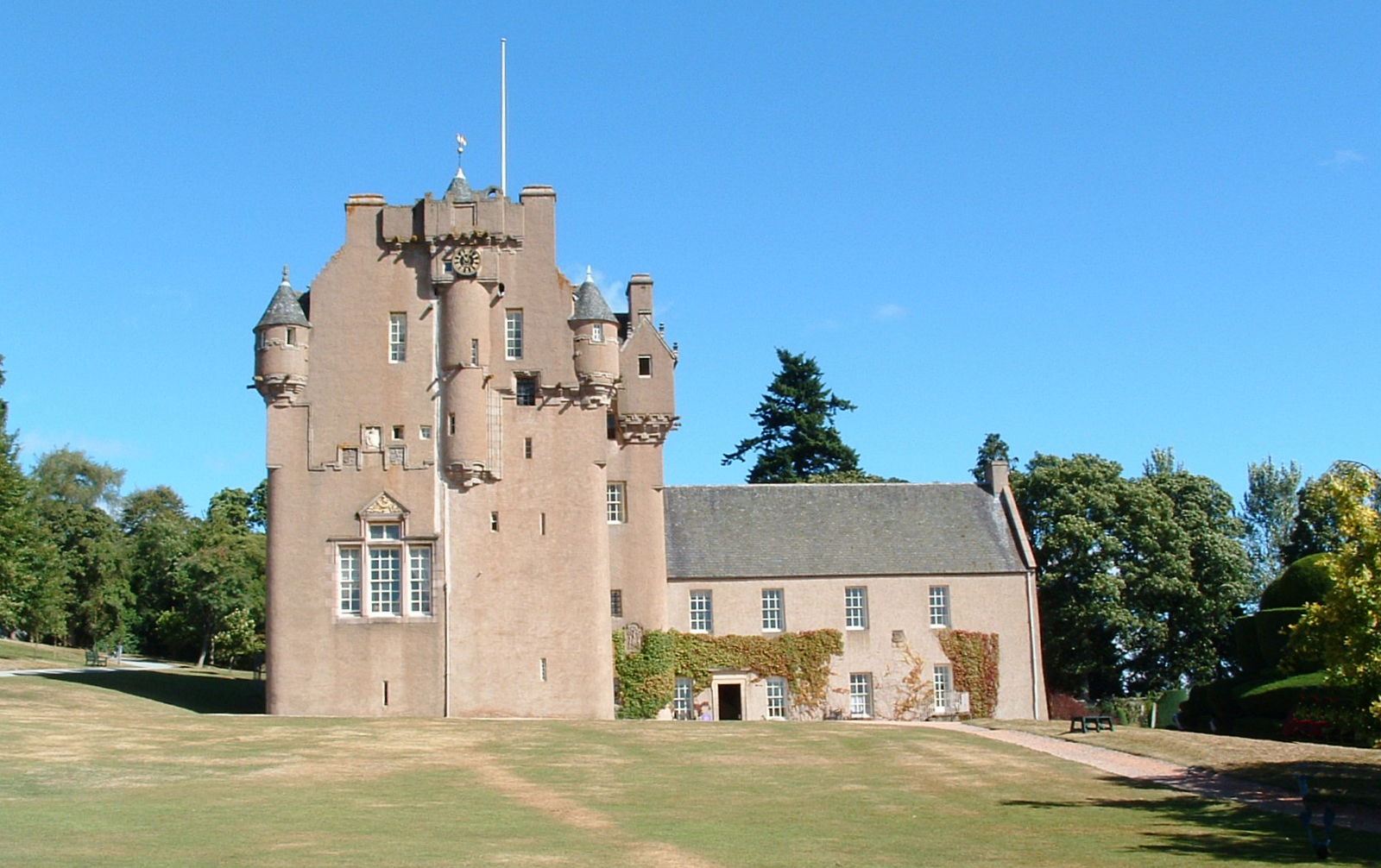
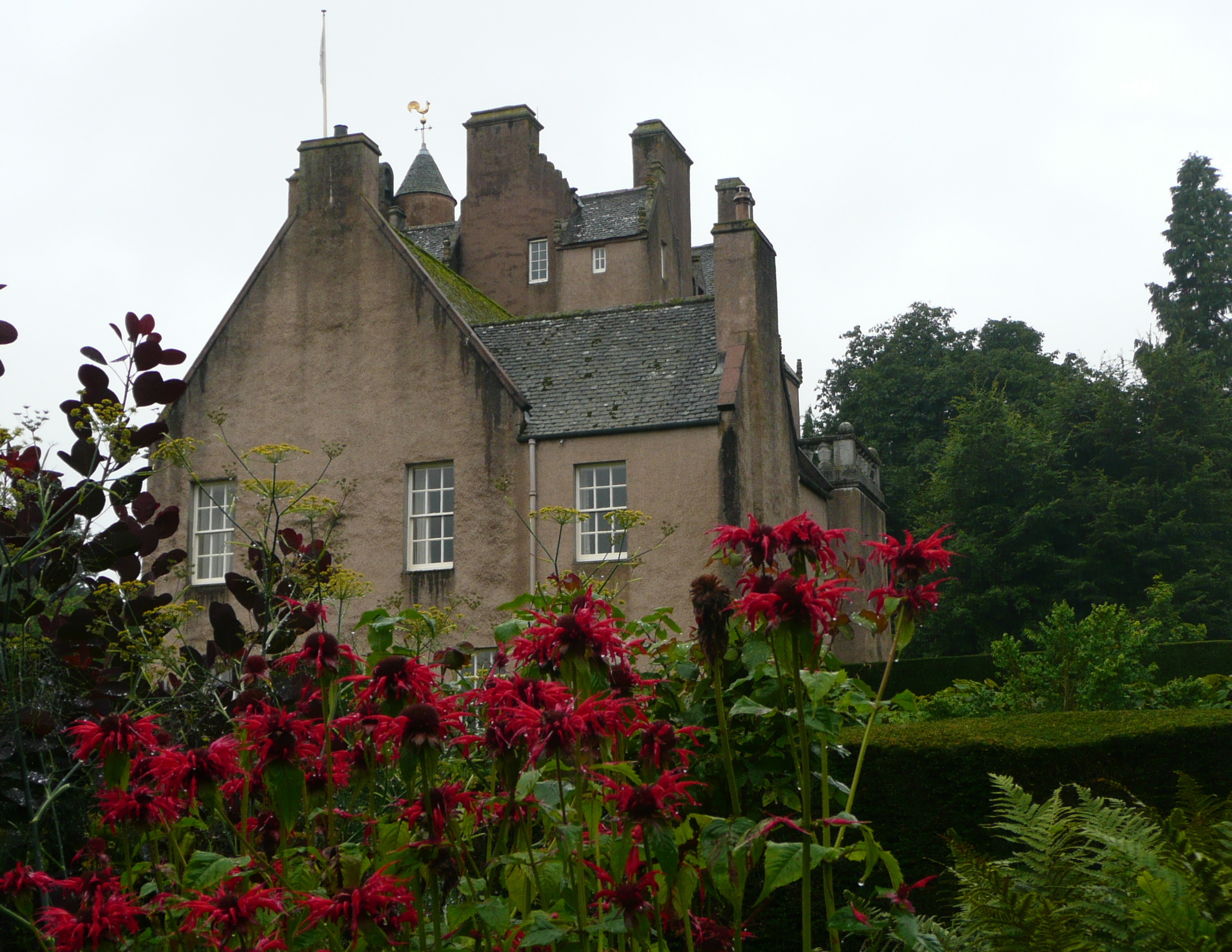 Urquhart Castle, Invernesshire (2003 & 2008)
Urquhart Castle
Urquhart Castle, Invernesshire (2003 & 2008)
Urquhart Castle lies in the
Great Glenn located on the shores of
Loch Ness. Originally constructed in the 13th century it played a significant role in the
Wars of Scottish Independence in the 14
th century. Held as a
Royal castle, it was continually raided by the
MacDonalds. Though granted to the
Clan Grant, conflict with the MacDonalds continued. Government forces partially destroyed it in 1692 to prevent its use by
Jacobite forces. In 1884 the castle came under the control of Caroline, Dowager Countess of Seafield. On her death in 1911, it was transferred to
Historic Environment Scotland. If it looks familiar, it is often shown in documentaries on the
Loch Ness Monster.
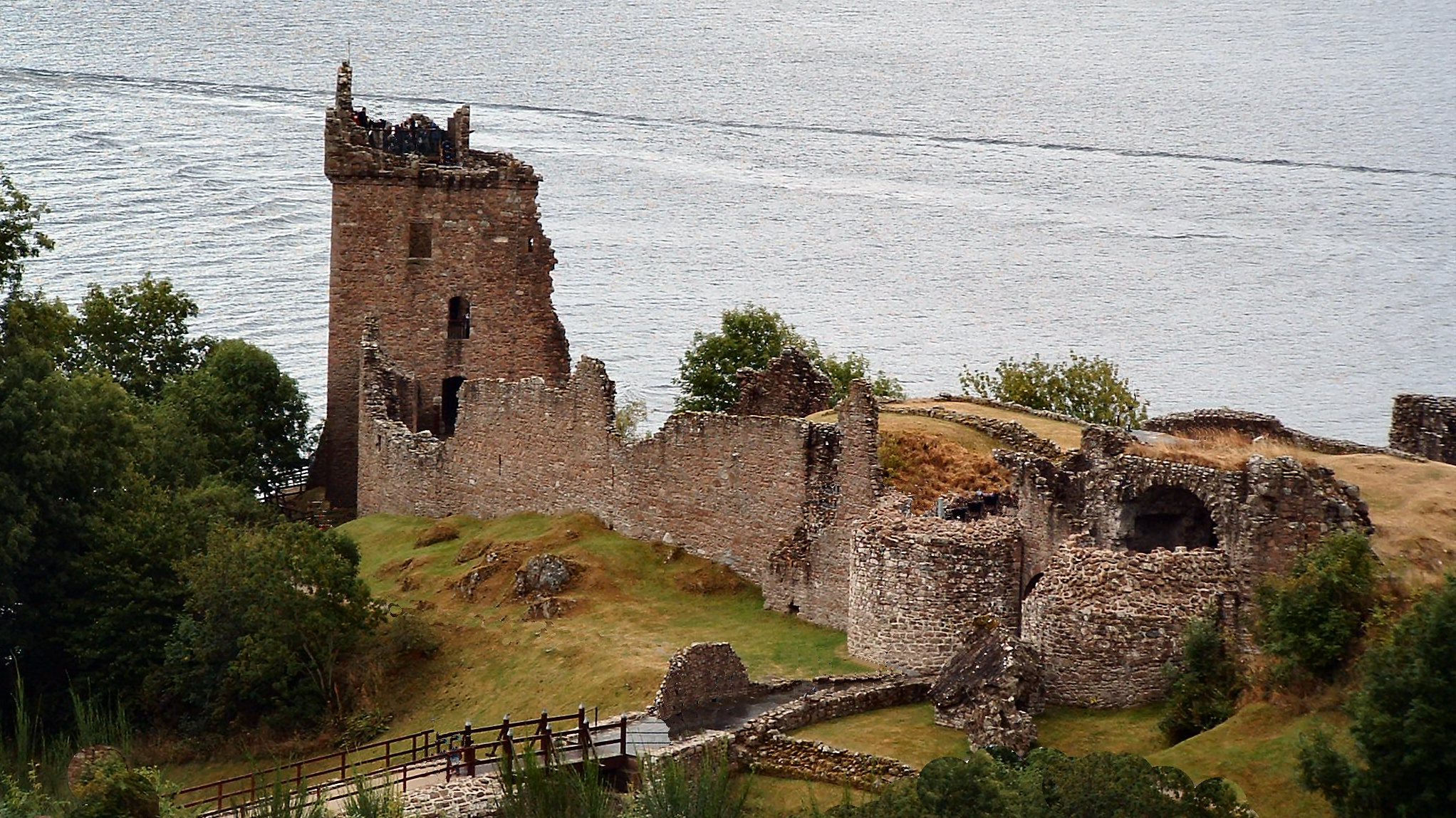
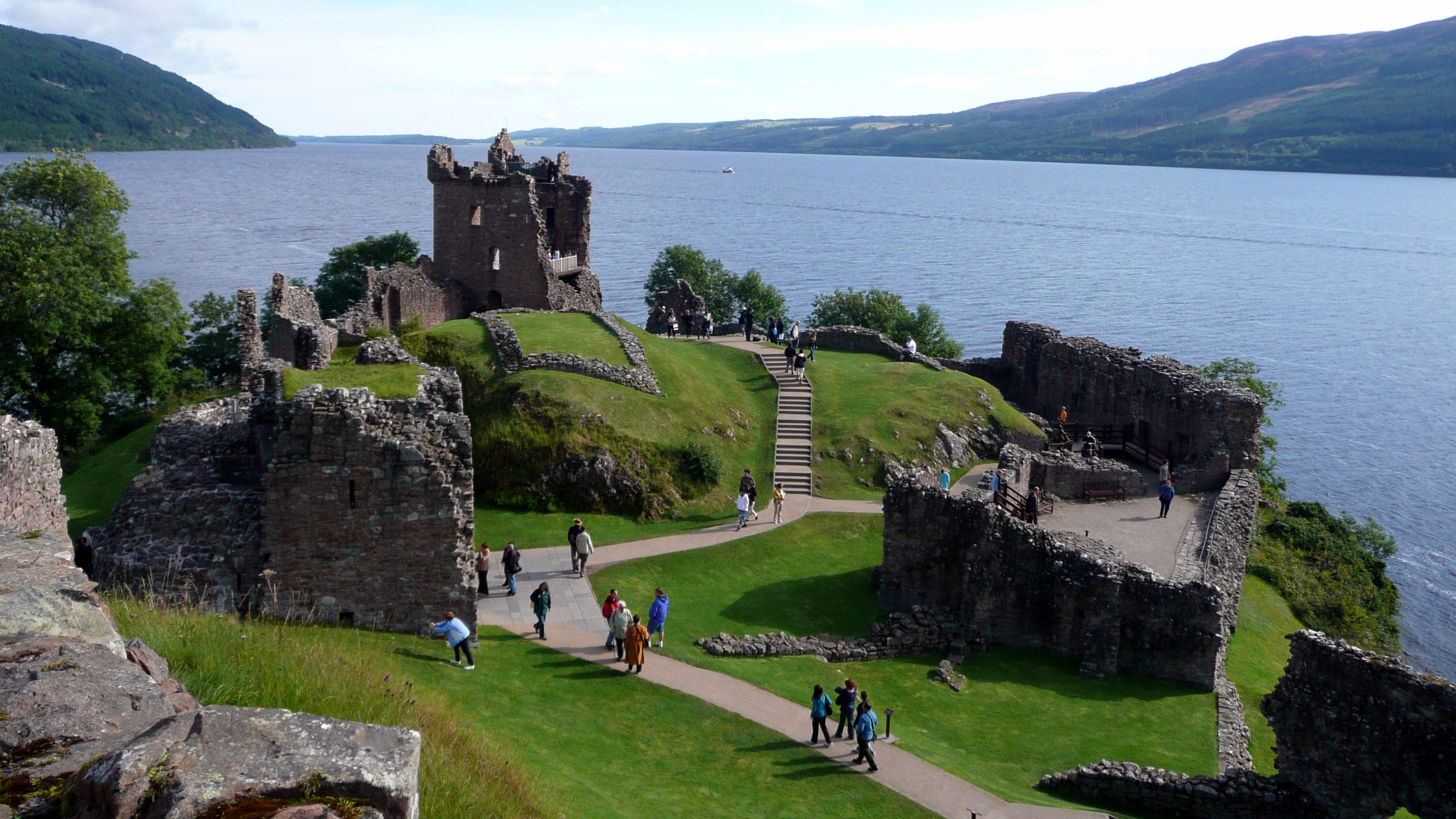
 Eilean Donan Castle, Aberdeenshire (2003 & 2011)
Eilean Donan
Eilean Donan Castle, Aberdeenshire (2003 & 2011)
Eilean Donan translates literally as the
Island of Donan. It lies at the confluence the three sea lochs
Loch Duich,
Loch Long and
Loch Alsh and was probably named for the 6
th century Irish Saint, Bishop Donan of Eigg.
The original castle was built on the island in the 13
th century, a stronghold of
Clan Mackenzie. However, in response to their support of the
Jacobite rebellions, government ships destroyed the castle in 1719. As it stands today, Eilean Donan Castle was rebuilt by
Lt. Col. John MacRae-Gilstrap from 1919 to 1932. The original castle was only accessible by boat or at low tide. The current
arched bridge was part of the reconstruction. Regardless, Eilean Donan Castle is considered to be the most photographed castle in Scotland. It has also been included in several movies including
Highlander in 1986 starring
Christopher Lambert.
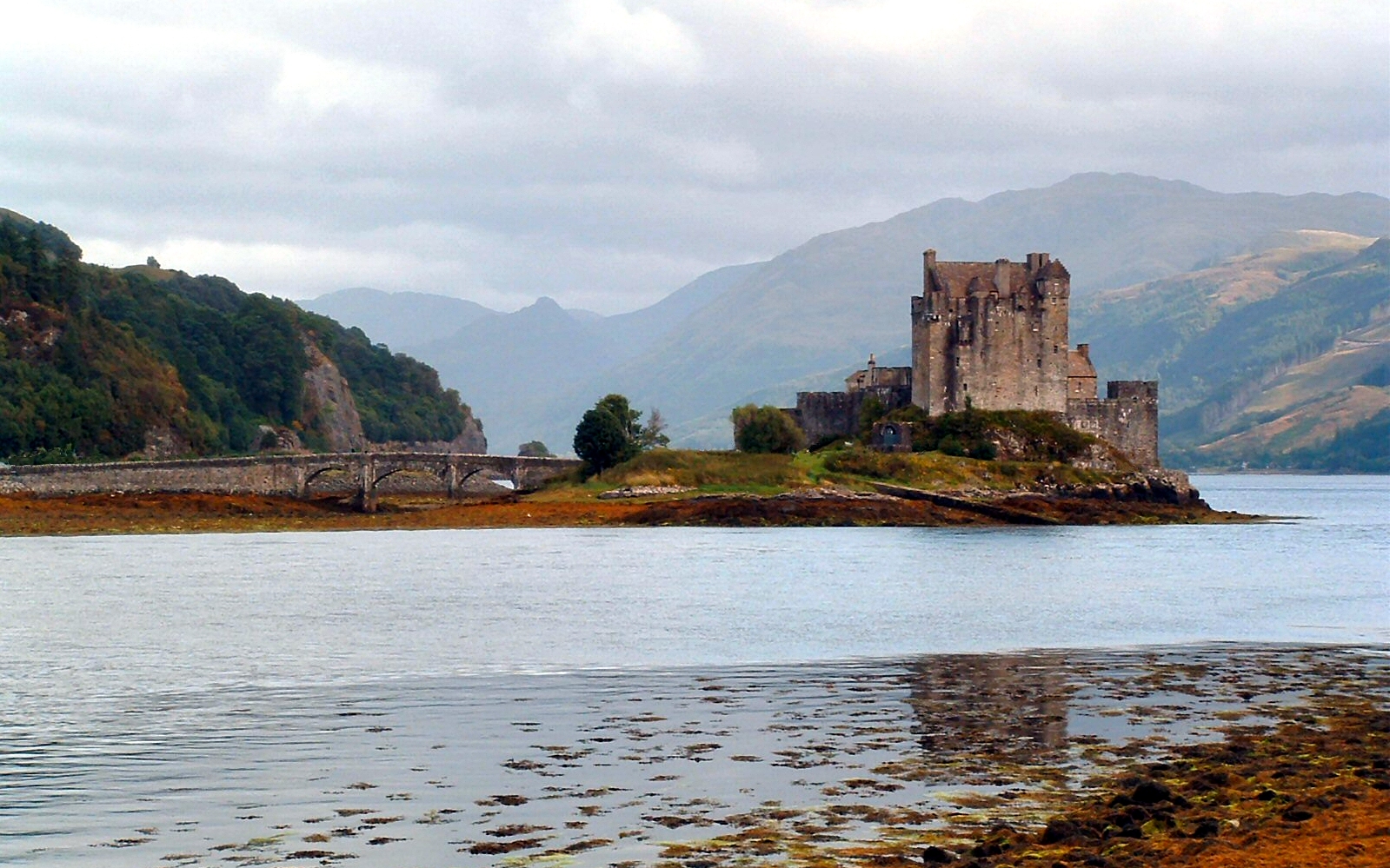
 Stirling Castle, Stirlingshire (2003, 2005 & 2022)
Stirling Castle
Stirling Castle, Stirlingshire (2003, 2005 & 2022)
Stirling Castle, sitting atop an extinct
volcano, is historically and architecturally quite significant. Its strategic location has made it an important fortification and a favorite site of
Scottish Royalty. The first record of Stirling Castle dates from around 1110, when
King Alexander I dedicated a chapel there, establishing a Royal residence. In its history it has been attacked at least 16 times and has withstood several sieges. One of the most brutal was by
Edward I, known as "
Longshanks" and the "
Hammer of the Scots", in 1304. In 1314,
Robert the Bruce actually laid siege to Stirling which at the time was an English garrison. B
onnie Prince Charlie, the Young Pretender, attempted to take the castle in 1746 but was unsuccessful.
Most of the buildings standing today were built in the 15th century and later.
James IV built the
Great Hall around 1500 and the
Royal Palace was built by
James V in the 1540s. Mary Stuart was crowned
Queen of Scots at age nine months and spent much of her childhood at Stirling. Her son
James VI of Scotland, later
James I of England, was baptized here.
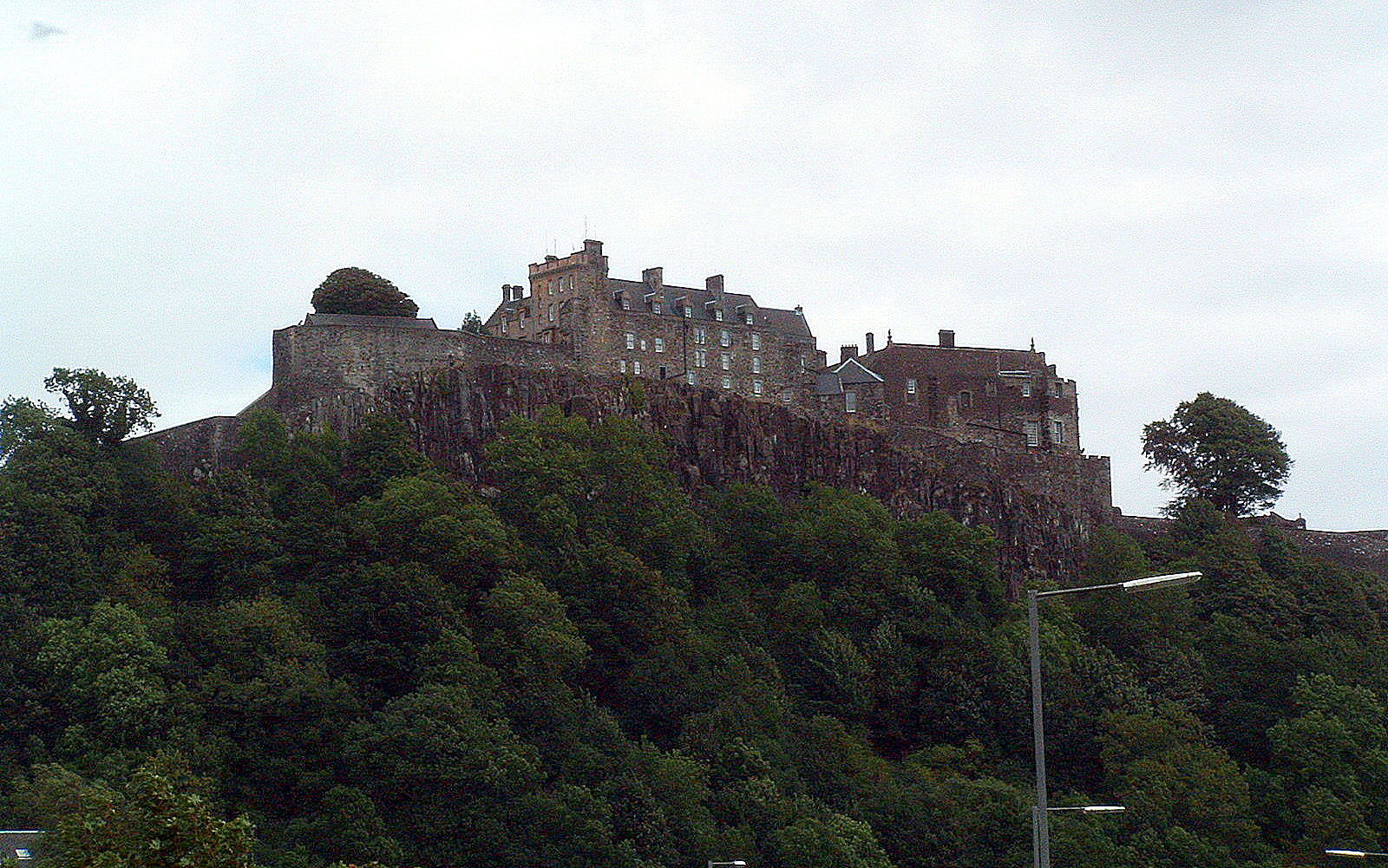
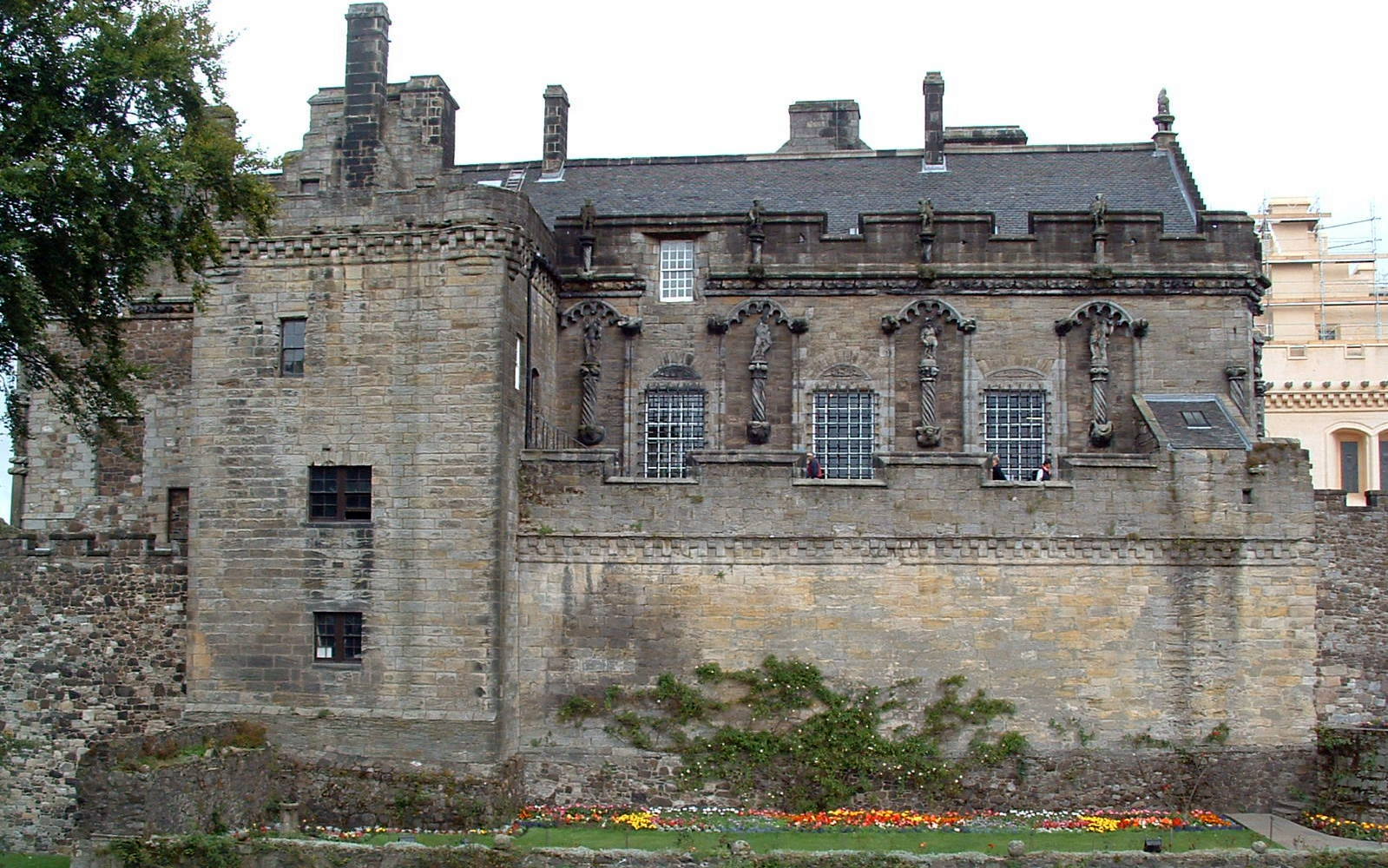
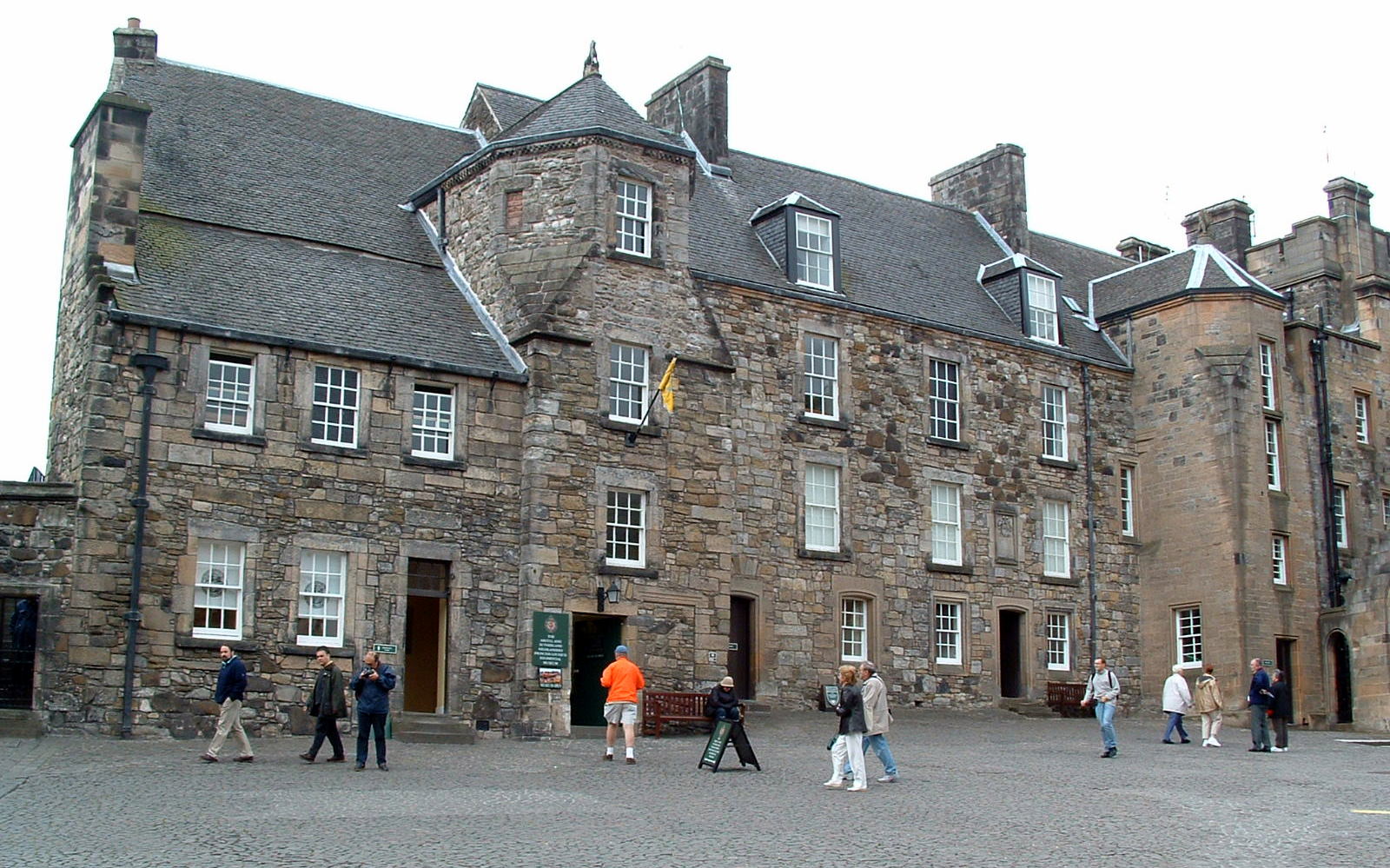
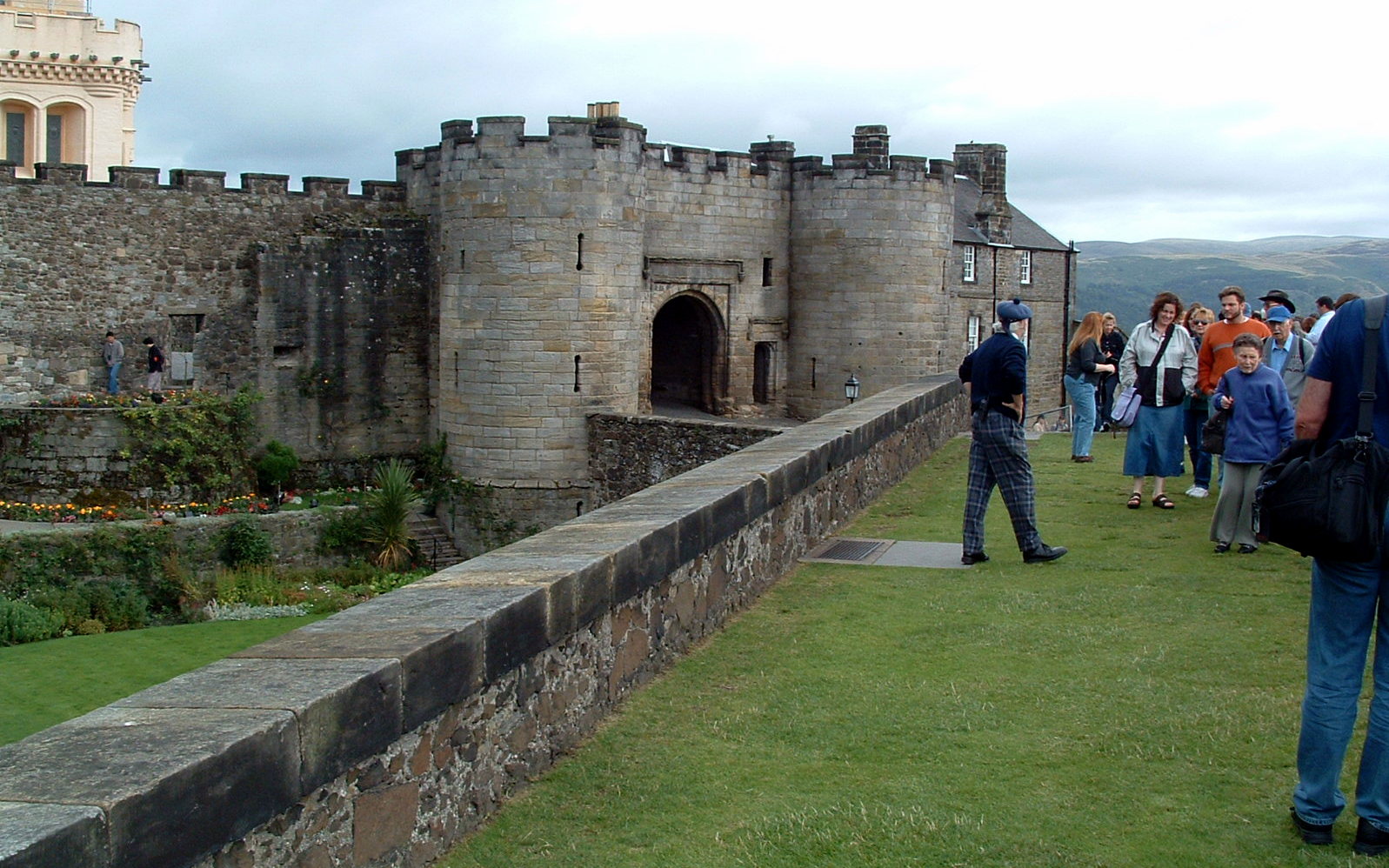
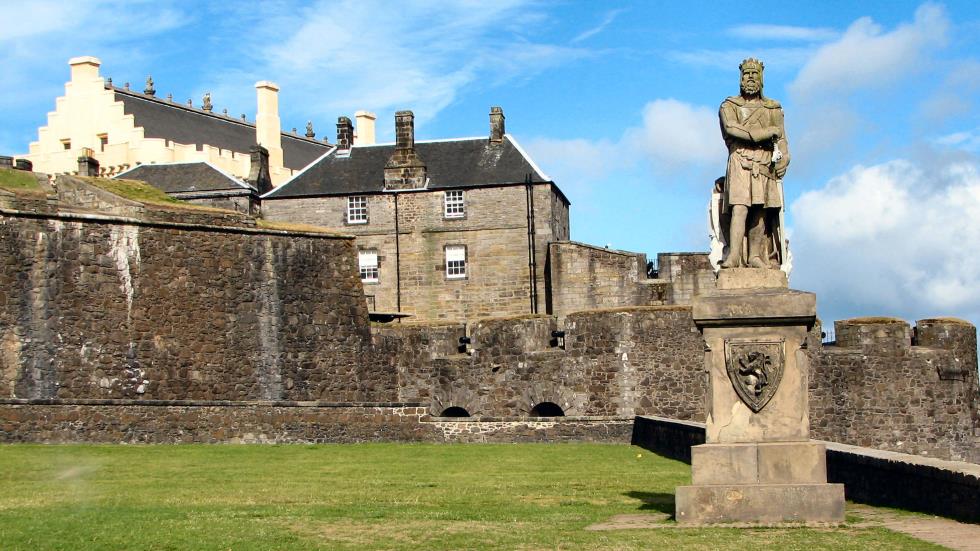
 Doune Castle, Perthshire (2003, 2005 & 2022)
Doune Castle, Perthshire (2003, 2005 & 2022)
Located at the confluence of
Ardoch Burn and the
River Teith,
Doune Castle, was originally built in the 13
th century. It was damaged in the
Scottish Wars of Independence and then rebuilt in the 14
th century by
Robert Stewart, Duke of Albany, son of Robert II. When Robert's son, Murdoch, was executed in 1425 on the return of James I, the castle passed to the
Crown and for many years used as a royal hunting lodge. Among its royal visitors was
Mary, Queen of Scots. In the 16th century, Doune became property of the
Earls of Moray. The castle saw much military action until, by 1880, the castle stood in ruins. At this time G
eorge Stuart, 14
th Earl of Moray began repair works. The castle is now maintained by
Historic Environment Scotland.
Doune has been the scene of numerous movie sets. It was featured in
Monty Python and the Holy Grail, used for the castle
Winterfell in
Game of Thrones and as
Castle Leoch in
Outlander.
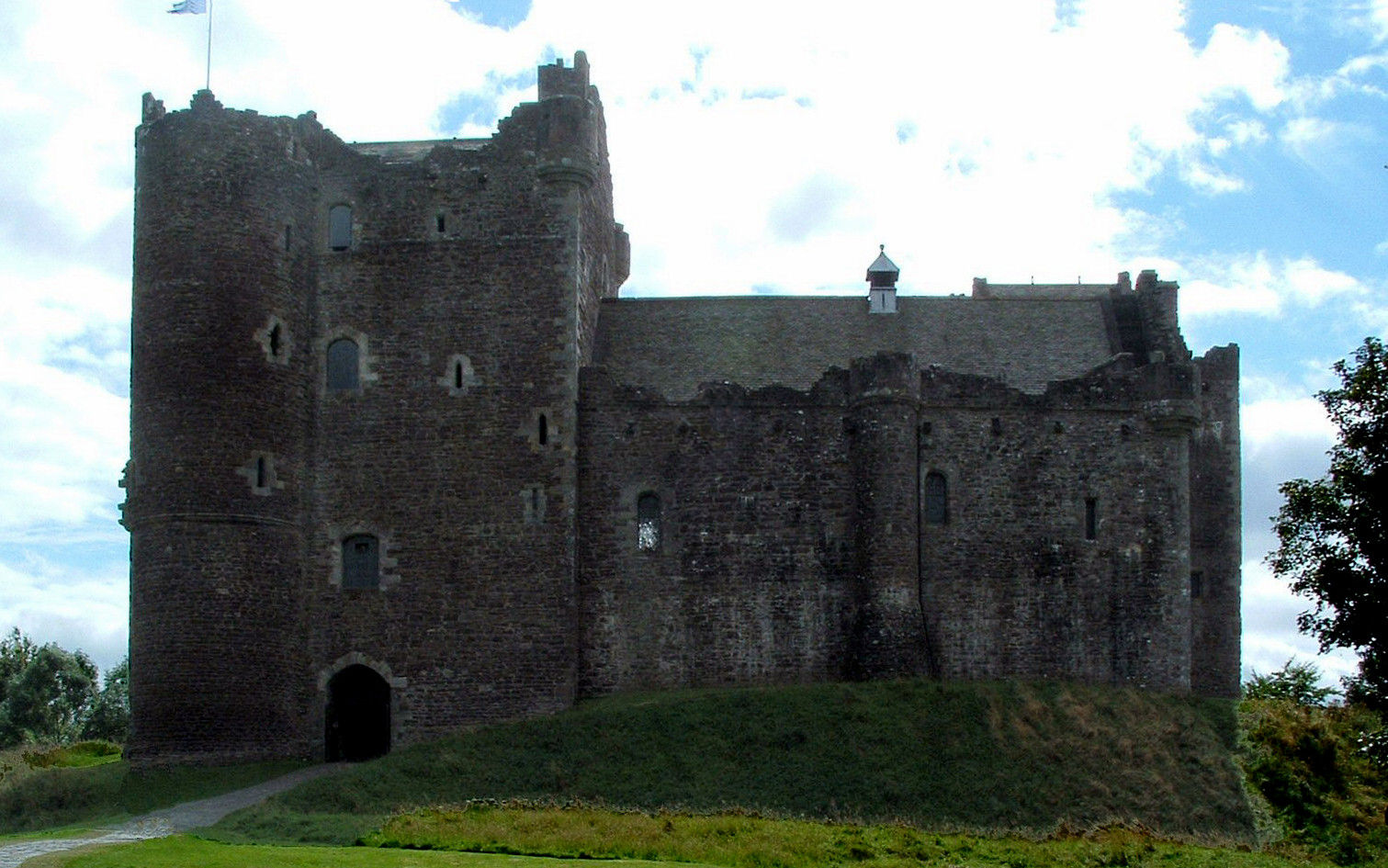
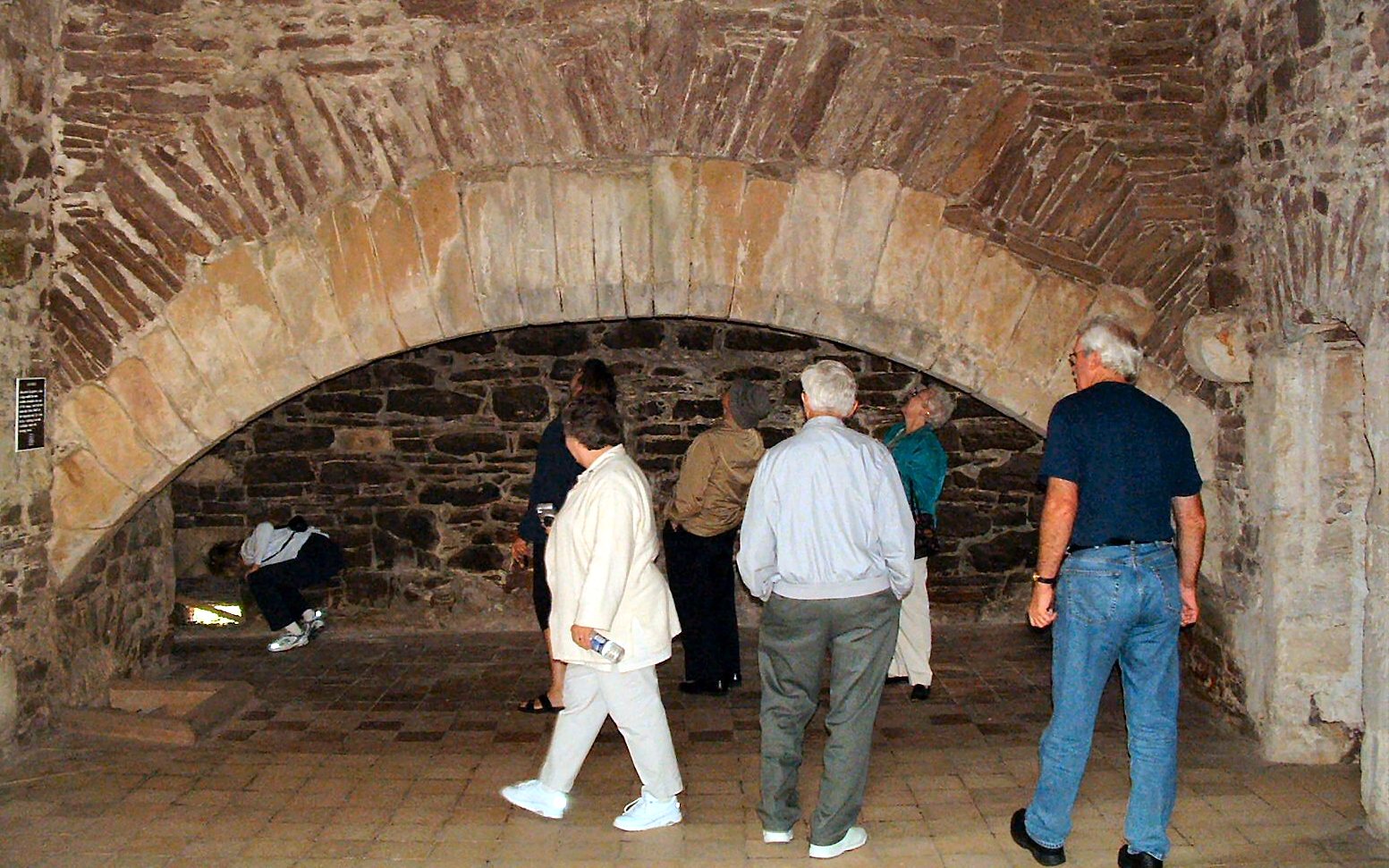
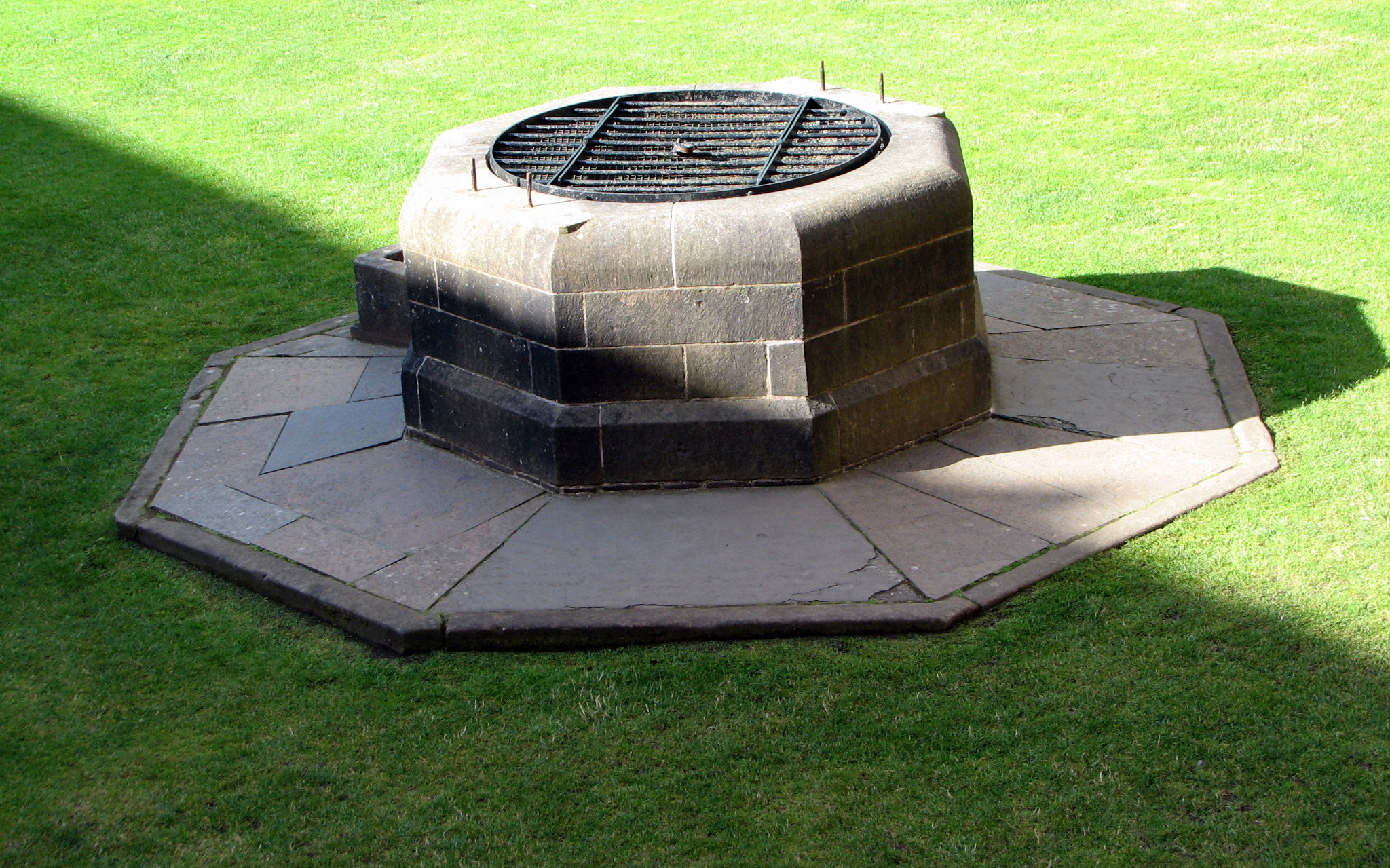 Floors Castle, Roxburghshire (2005)
Floors Castle, Roxburghshire (2005)
Designed by the architect
William Adam for
John, Duke of Roxburghe, Floors was constructed in the 1720s. It really does not fit any of the standard types of castles and without the crenellations, it might not be called a castle at all. It is thought that it incorporated an earlier
Tower Castle from which it got its name. It was designed in the common 18
th century main block with two symmetrical service wings. In the 19
th century it was embellished with turrets and battlements by the
6th Duke of Roxburghe.
Floors, considered to be the
Gem of the Scottish Borders, lies on the hill just west of Kelso overlooking the
River Tweed. The Borders, also referred to as the
Marches, is the area adjoining England. In earlier times it was the haunt of
Reivers, both Scottish and English, who raided back and forth through the area without regard to nationality.
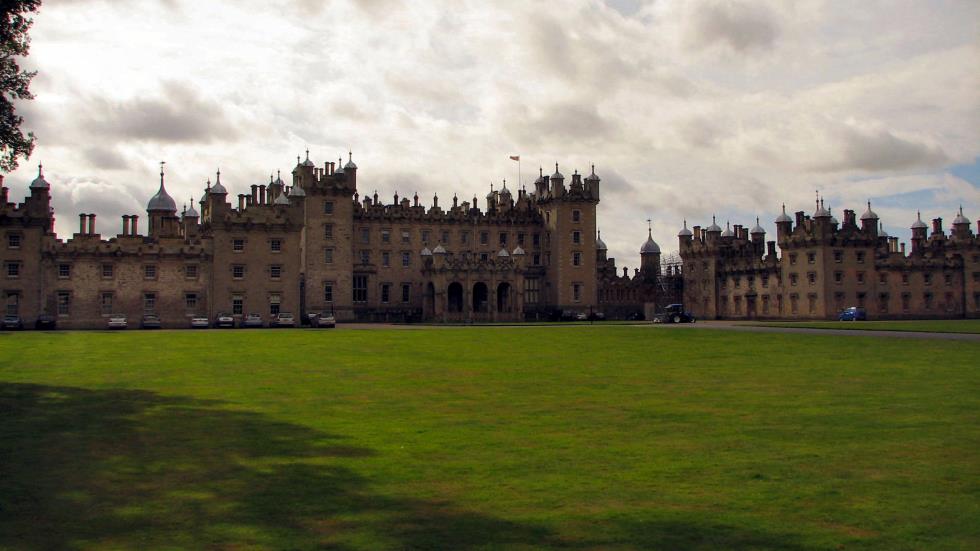
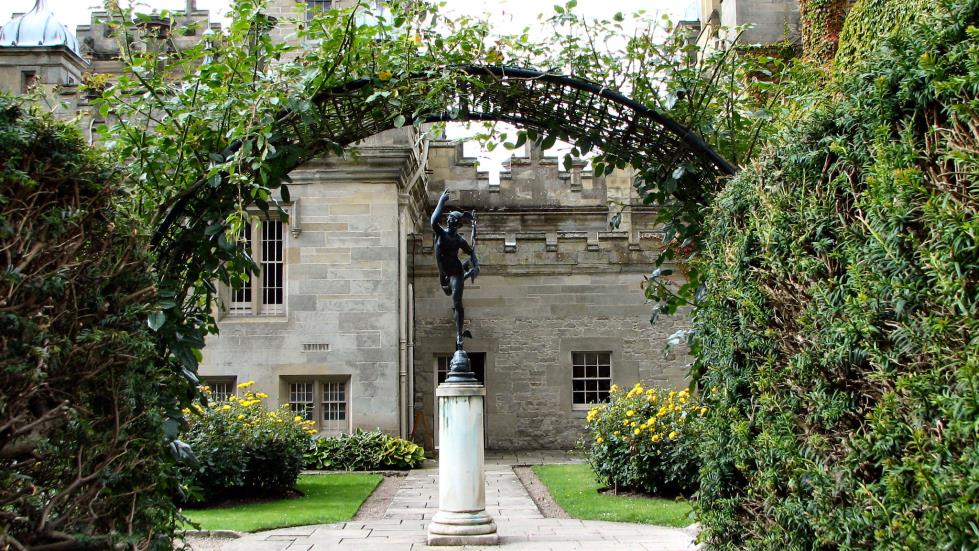 Abbotsford, Roxburghshire (2005 & 2008)
Abbotsford
Abbotsford, Roxburghshire (2005 & 2008)
Abbotsford, the home of novelist and poet
Sir Walter Scott, is not castle, but it looks like one (more so than Floors). And besides, it one of my
favorite places in all of Scotland. Sitting on the south back of the
River Tweed, it has been described as a
baronial estate. Built by Scott between 1817 and 1825, it is named for the river ford used by the Abbots of nearby
Melrose Abbey. With its central tower and many corner towers and
bartizans capped with spires, it could easily be mistaken for a fairy tale castle. I'm sure Sir Walter took his inspiration from the likes of
Ivanoe and
The Lady of the Lake.
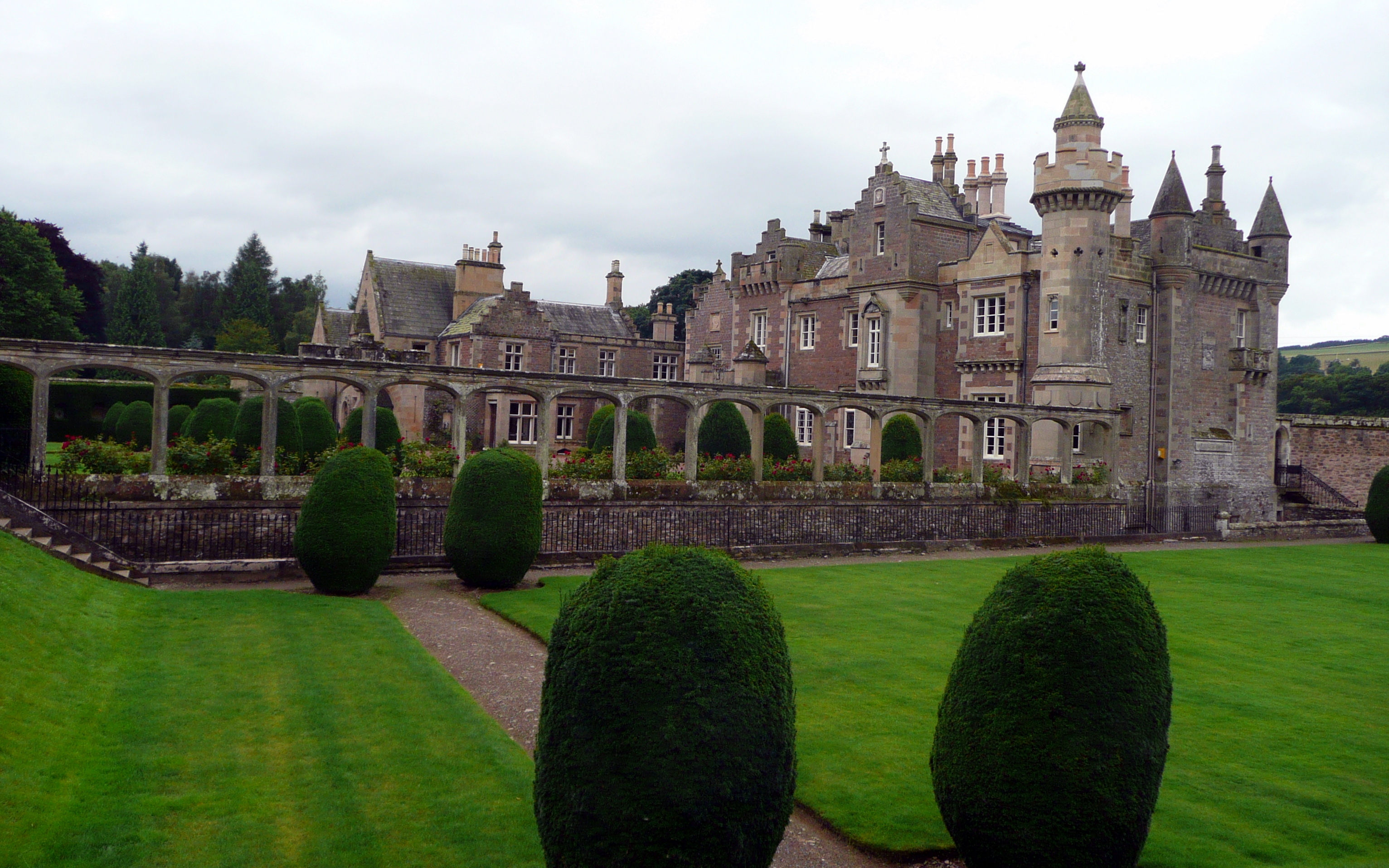
 Dunrobin Castle, Southerland (2008 & 2011)
Dunrobin Castle
Dunrobin Castle, Southerland (2008 & 2011)
Dunrobin Castle, with its fairy tale
spiral towers sits on the banks of the
Dornoch Firth. It is the most northerly of Scotland's great houses. It is also one of Britain's oldest continuously inhabited houses dating back to the early 1300s, home to the Earls and later, the
Dukes of Sutherland. The oldest surviving part of the present Dunrobin Castle dates back to 1401. At that time it was a square
Keep with walls over six feet thick.
During the
Rising of 1745, the
Jacobites under
Bonnie Prince Charlie stormed Dunrobin. The 17
th Earl of Sutherland fled to Aberdeen but was reinstated when the Bold 45 failed the following year.
Between 1835 and 1850 the castle was remodeled in the
Scottish Baronial style by the the 2nd Duke of Sutherland. During
WWI it was used as a naval hospital. Since the early 70s the house and grounds have been open to the public, though the
Sutherland family retains private accommodations.

 Blair Castle, Perthshire (2008)
Blair Castle
Blair Castle, Perthshire (2008)
Blair Castle is the ancestral home of the
Clan Murray, and was historically the seat of their chief, the
Duke of Atholl. Construction started in 1269 by
John I Comyn, Lord of Badenoch while the Earl of Atholl was away on crusade. On his return, he won back his land and incorporated the tower that had been built into his own castle.
David II Strathbogie, Earl of Atholl, died in 1326 and forfeited the titles and estates after rebelling against
King Robert the Bruce in 1308. The earldom was granted to a number of individuals over the years until 1457 when
James II granted it to his half-brother John Stewart. John Murray was created Earl of Atholl in 1629, and the title has since remained in the
Murray family.
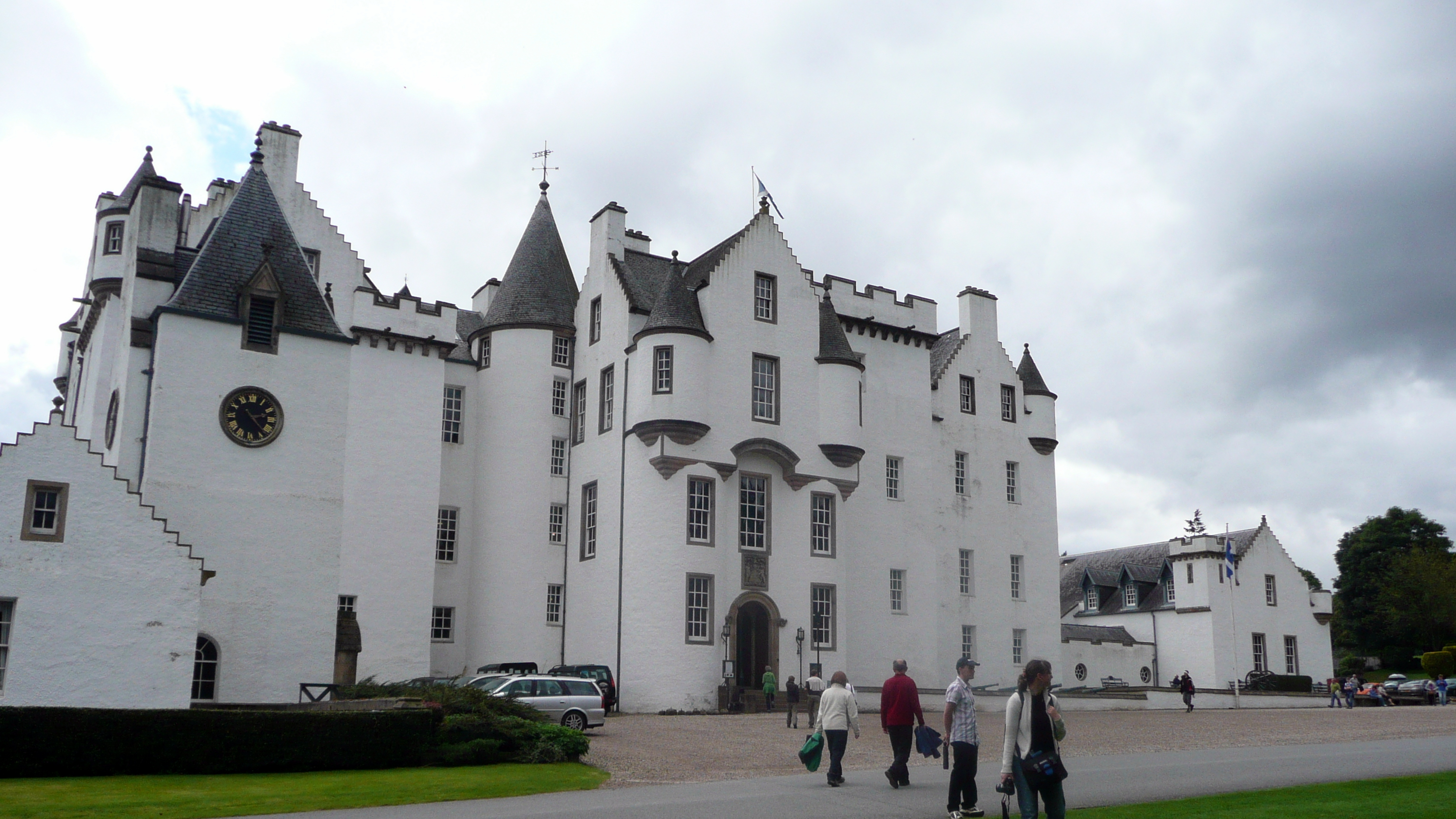 Duart Castle, Argyll and Bute (2008)
Duart Castle
Duart Castle, Argyll and Bute (2008)
Duart Castle, the seat of
Clan MacLean, dates back to the 13
th century. It came to the MacLeans from Clan
MacDougal when Lachlan MacLean, the 5
th Clan Chief, received it as part of his dowry on his marriage with
Mary, daughter of John of Islay, Lord of the Isles. In 1691, Duart was surrendered to the 10
th Earl of Argyll who partially demolished the castle. Though abandoned in 1751 with the castle in ruins, it was eventually bought by
Sir Fitzroy Donald Maclean, the 26th Chief of the Clan MacLean, and restored.
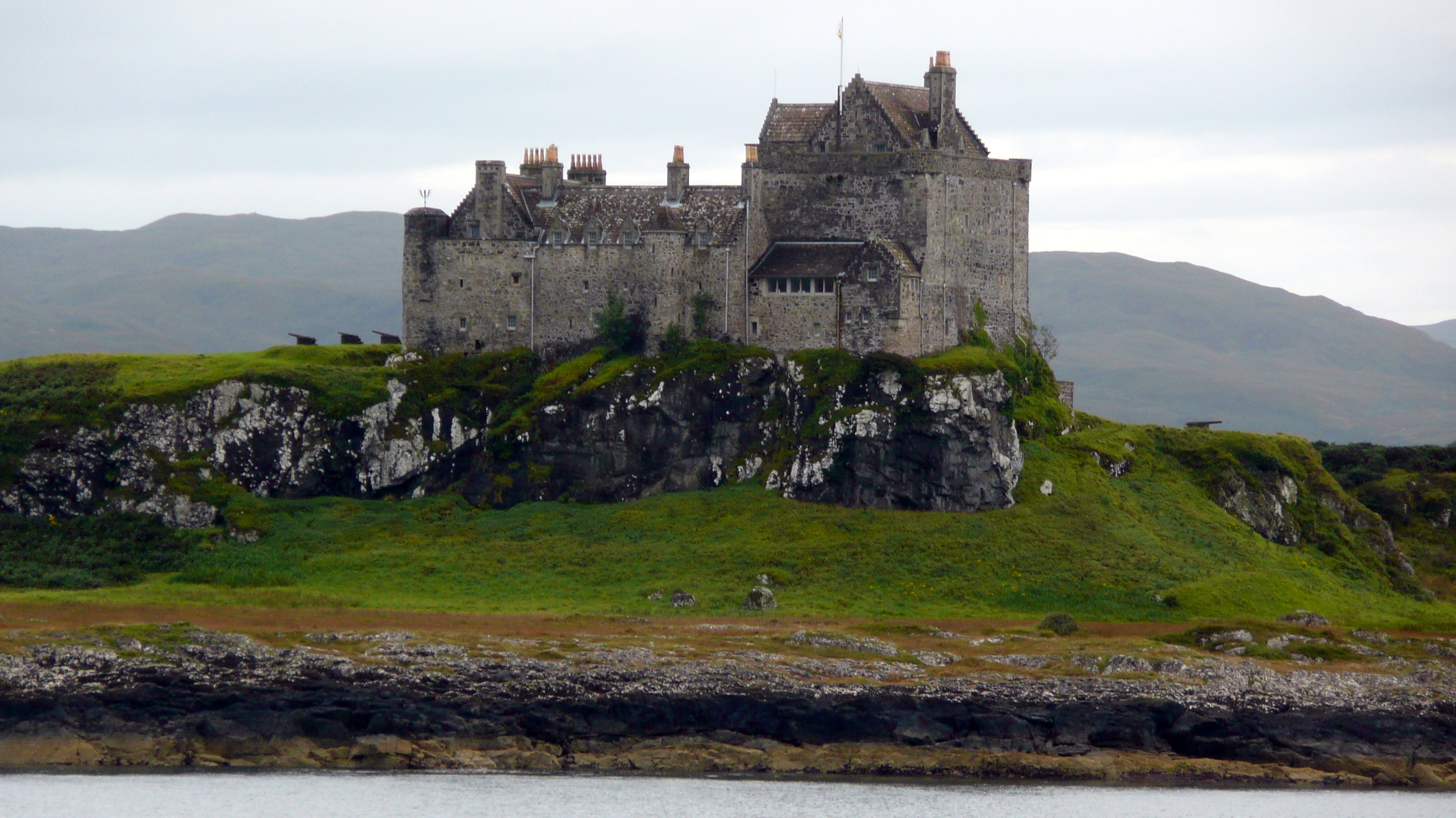 Castle Stalker, Argyll and Bute (2008)
Castle Stalker
Castle Stalker, Argyll and Bute (2008)
Castle Stalker, built by
Clan Stewart around 1440, sits on a tidal islet in
Loch Linnhe. Unfortunately, while visiting the castle in 1620,
King James IV lost the castle on a drunken bet to the
Campbells. The Campbells abandoned it around 1840 when the roof collapsed.
Charles Stewart boght the castle in 1908 and began restoration. In 1965
Lt. Col. D. R. Stewart Allward acquired the castle and, over the next ten years, fully restored it. It was used in the filming of
Monty Python and the Holy Grail as "
The Castle Aaaaarrrrrrggghhh" and later in the film
Highlander: Endgame.
 Corgarff Castle, Aberdeenshire (2008)
Corgarff Castle, Aberdeenshire (2008)
Built in 1530 by the
Elphinstone family, Corgarff Castle is an excellent example of a
walled Tower Castle. We passed near it on the way to the
Glenlivet Distillery.
 Castle of Mey, Caithness (2008)
Castle of Mey, Caithness (2008)
The
Castle of Mey is located on the northeast coast of Scotland just west of the town of
John o' Groats. The Castle of Mey was built between 1566 and 1572 on the site of an earlier fortification by
George Sinclair, 4th Earl of Caithness. Originally a
Tower House, a wing has been added to the southeast and a square tower on the northwest. Over the years it became derelict though it was used in
WWII as an officer's rest home. In 1952, the estate was purchased by
Queen Elizabeth The Queen Mother, the widow of George VI who set about restoring it to use as a holiday home. She visited regularly from 1955 until her death in 2002. In 1996 she created the
Queen Elizabeth Castle of Mey Trust, which has opened the castle and garden to the public since her death. Her purchase of the castle is featured in Season 1 Episode 8 of the Netflix show
The Crown.
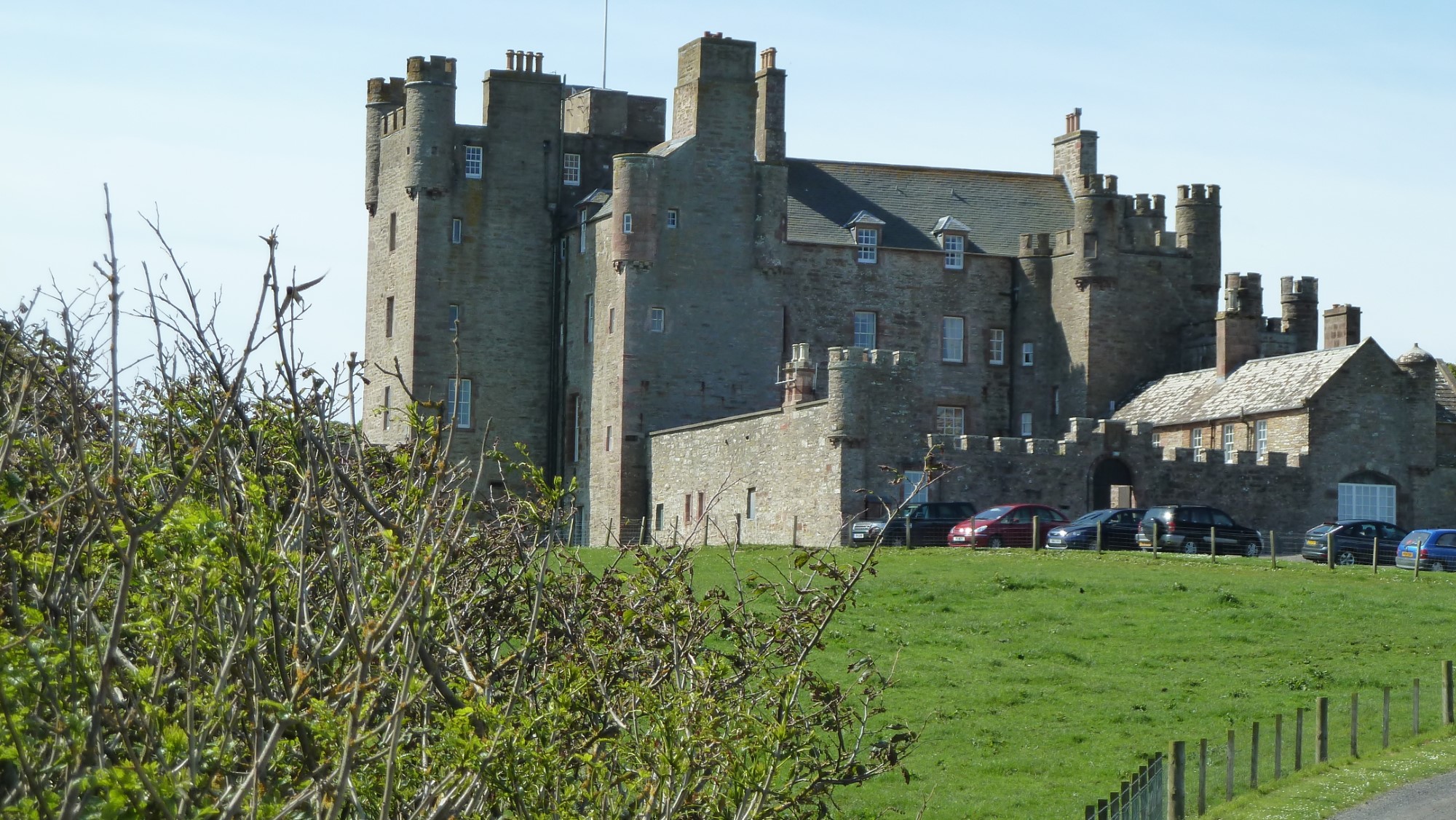
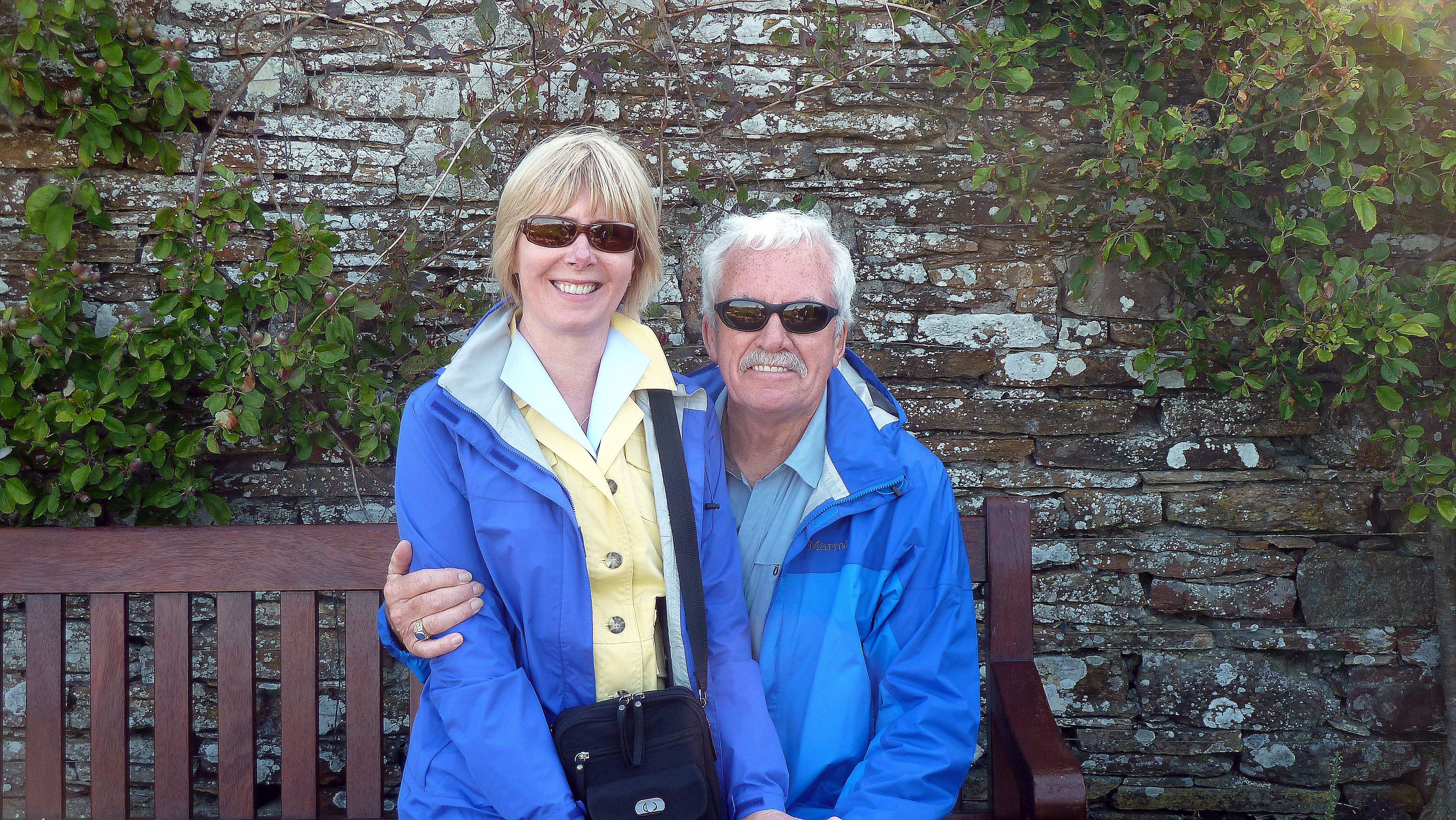 Scone Palace, Pert and Kenross (2022)
Scone Palace
Scone Palace, Pert and Kenross (2022)
Scone Palace has been home to the
Earls of Mansfield for over
400 years. Scone dates from at least the 9
th century and is the historic crowning-place of the
Kings of Scots and historic home to the Stone of Scone (the
Stone of Destiny).
Kenneth MacAlpin, traditionally known as the first King of Scots, was the first of
42 Scottish Kings that were crowned at Scone. No king had the authority to reign as king of Scots unless he had first been crowned at Scone upon the Stone of Scone. The Stone sat upon
Moot Hill.
In 1296
Edward I of England captured the Stone and removed it to London. The Stone was then used for the coronation of English and British monarch for over 500 years. In 1950, a Glasgow University student,
Ian Hamilton, along with his fellow studend
Kay Matheson, stole the Stone and, in the process, broke it in two. They later buried the larger piece in a field near Rochester, Kent, while Kay kept the smaller in a friend's garage in Birmingham. Sixteen months later the Stone was returned to London. In 1996
Queen Elizabeth II, who had been crowned with the Stone under the Coronation Chair, returned the Stone to Scotland. It now resides in Edinburgh Castle along with the
Scottish Honours. However, it is still considered a British, not just Scottish, asset and was returned to London for the Coronation of
King Charles III.
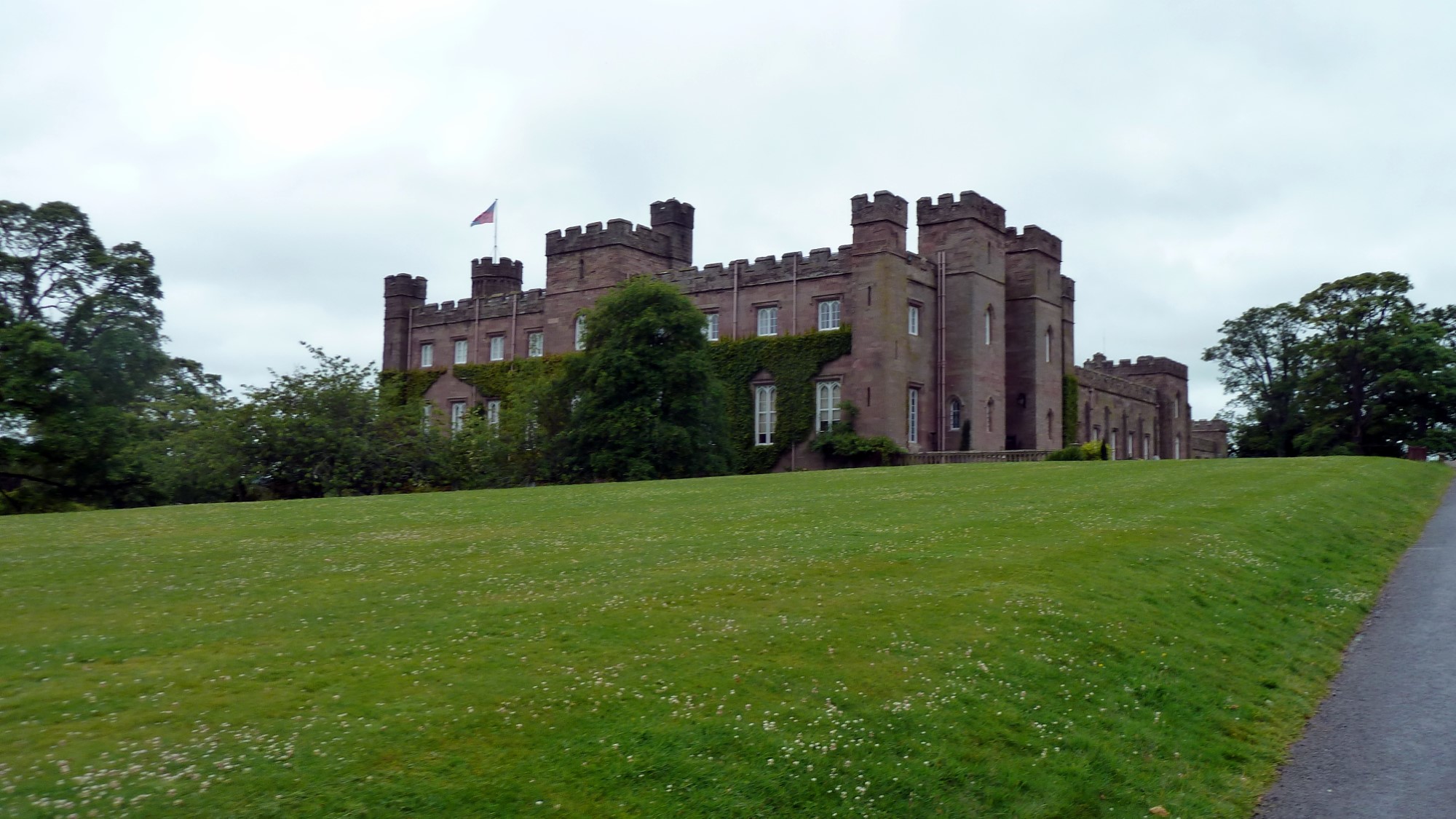
 Blackness Castle, West Lothian (2022)
Blackness Castle, West Lothian (2022)
Lying on the shore of the
Firth of Forth,
Blackness Castle was constructed in the 1440s by
Sir George Crichton, 1st Earl of Caithness. He moved to entail his property to prevent his son,
James from succeeding to his estate and titles. In retaliation, James imprisoned his father in Blackness Castle. George was rescued by
King James II and, in a compromise, James received the ancestral estate of Cairns and some crown land in Perthshire. George agreed to pass the remainder of his lands to the Crown on his death where they remain to this day. Because of its long, narrow shape, the castle has been characterized as "
the ship that never sailed".
 Dundonald Castle, South Ayrshire (2022)
Dundonald Castle, South Ayrshire (2022)
Sitting on a hill overlooking the town of
Dundonald, the third, and current Castle was built in 1371 for
Robert II on his ascension to the throne. It was used by him and his son
Robert III as a royal residence. Prior to this there were two other castle built on what was probably an ancient hill fort. The first castle was probably built by Walter, a Steward to the King, who came to Scotland in 1136. The second castle was built in the late 13th century by the 4
th High Steward, Alexander. It was largely destroyed in the
Wars of Scottish Independence in the early 14
th century by
Robert the Bruce.
 Turnberry Castle, Ayrshire (2022)
Turnberry Castle
Turnberry Castle, Ayrshire (2022)
Turnberry Castle is not much more than a pile of rocks. It is exceptional for the fact that it is thought to be the birthplace of
Robert the Bruce. There is no record of when it was originally built but it began as a stronghold of the
Lords of Galloway. It passed to the possession of the
Earls of Carrick around the beginning of the 13
th century. It was held at this time by Marjorie, the
widowed Countess of Carrick. Legend has it that, while visiting the castle,
Robert de Brus, father of
Robert the Bruce, was held captive by Marjorie until he agreed to marry her. He agreed and with their marriage in 1271, was conveyed both the castle and the earldom. It is not certain that Robert was born there, but that he spent his youth in the castle is not in doubt.
Robert the Bruce, as with many other castles, ordered it destroyed in 1310 to prevent it from falling into English hands. Four years later at the
Battle of Bannockburn, he soundly defeated the English and was proclaimed
King of Scotland.
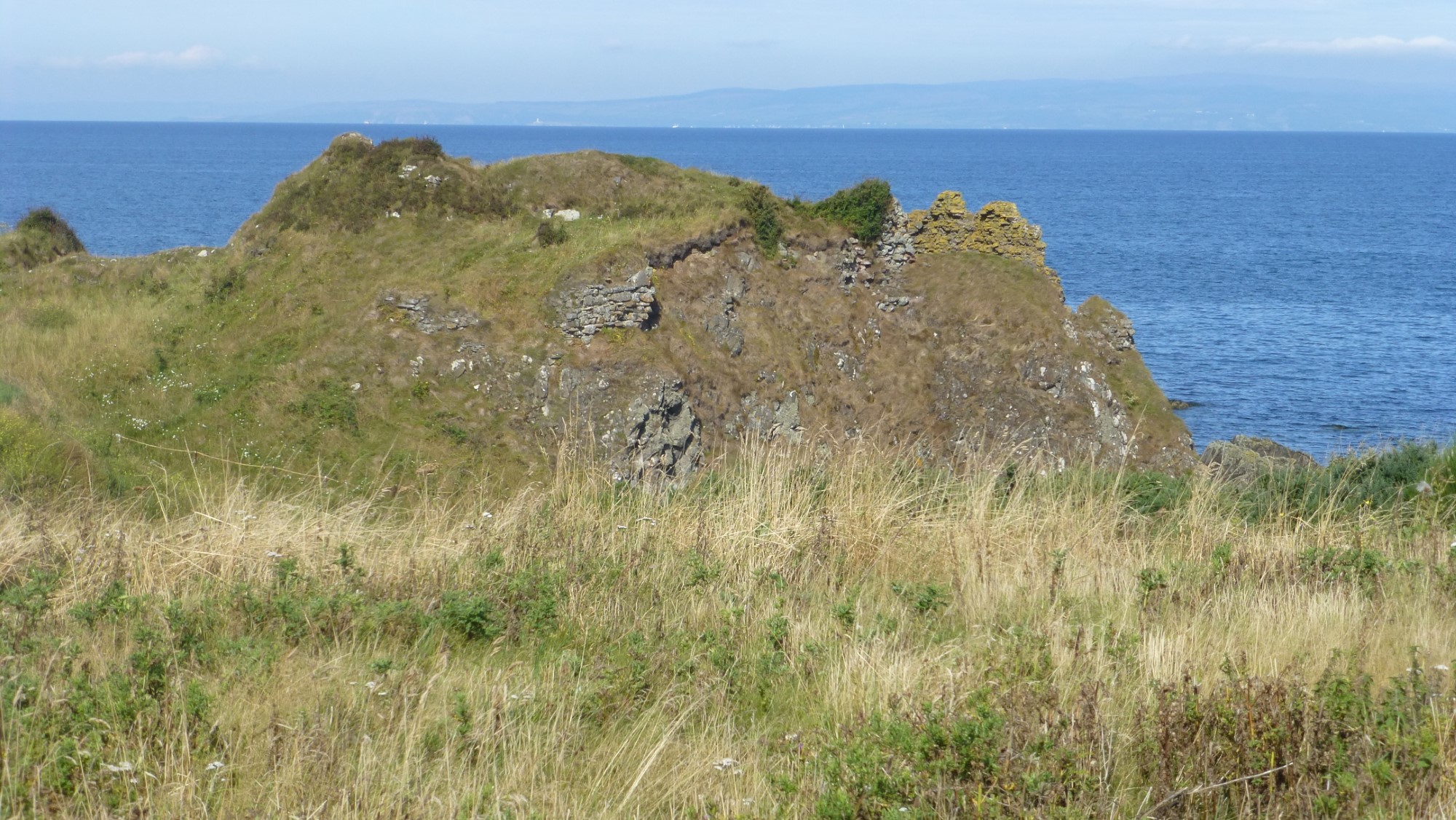 Castle Caerlaverock, Dunfries and Galloway (2022)
Caerlaverock Castle
Castle Caerlaverock, Dunfries and Galloway (2022)
Caerlaverock Castle, besides having the coolest name for a castle, it is the only
triangular castle in the UK and only one of a handful in the world. A moated
Stone Keep it is located on the coast of the
Solway Firth. Built in the 13
th century, it was a stronghold of the
Maxwells until the 17
th century when it was abandoned after being besieged by the
Protestant Covenanter army. At that time the south wall and tower were demolished.
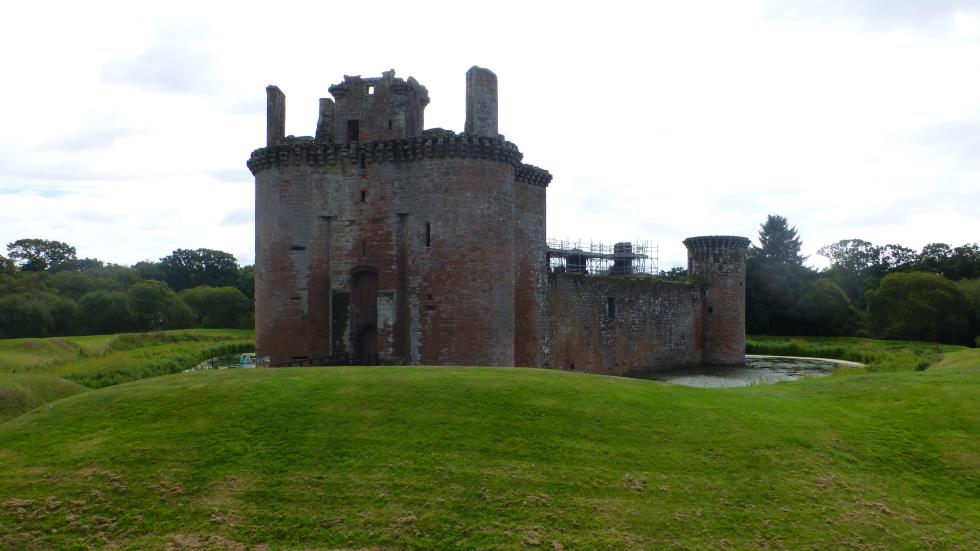 Lochmaben Castle, Dunfries and Galloway (2022)
Lochmaben Castle, Dunfries and Galloway (2022)
Built in the early 14
th century by
Longshanks (also known as
The Hammer of the Scots), it replaced an earlier Motte and Bailey castle built south of the current castle in c.1160 by the
Bruce family, Lords of Annandale. The castle was seized by
Lord Maxwell, seeking to overthrow the
Protestant Monarchy in 1588. In response
James VI besieged Lochmaben with the assistance of English forces.
Lochmaben Castle remained important with a turbulent history until some time after the early 1
7th century.
King James I allotted £1,600 sterling for its repair in 1624 but it was never put to use. Today it has fallen into total disrepair and is not accessible to the public.
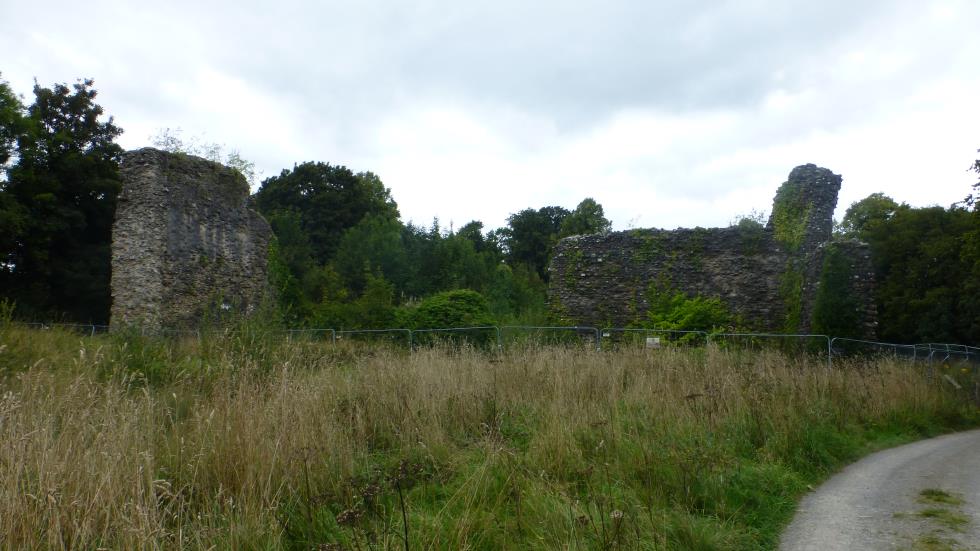





 To Irish Castles & Palaces
To Irish Castles & Palaces